 |
|
Hi, you're in the Archives, October 2006 - Part 2 |
|
|
|
|
 |
|
|
|
October
25, 2006 |
|
 |
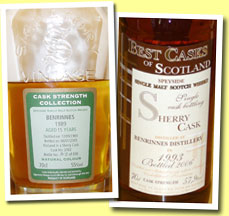 |
Benrinnes
15 yo 1989/2005 (55%, Signatory,
cask #2363, 690 bottles)
 Colour: gold. Nose: a very toasted
and rather coffeeish start,
also very malty. Quite powerful.
Lots of cornflakes, maple syrup,
candy sugar, roasted nuts, hot
cake… It’s maybe
a tad too spirity, let’s
see if water will make it more
complex. Yes, that works despite
a temporary soapiness as often.
It gets both meatier and more
flowery, with also hints of
peat, wet hay and orange zest.
Definitely nicer with water.
Colour: gold. Nose: a very toasted
and rather coffeeish start,
also very malty. Quite powerful.
Lots of cornflakes, maple syrup,
candy sugar, roasted nuts, hot
cake… It’s maybe
a tad too spirity, let’s
see if water will make it more
complex. Yes, that works despite
a temporary soapiness as often.
It gets both meatier and more
flowery, with also hints of
peat, wet hay and orange zest.
Definitely nicer with water.
|
| Mouth
(neat): an extremely sweet, fruity,
almost sugary attack, on various
kinds of sweets (mostly pineapple
or orange-flavoured ones) and
fruit liqueurs (parfait amour,
pineapple, manzana). Lots of bubblegum
as well, grenadine, cranberry
juice… Then we have a little
smoke, candy sugar again, corn
syrup, strawberry jam… Immensely
sweet and fruity, really, to the
point where not much else manages
to come through, except maybe
honey. I like this extravagance
I must say, anything but boring.
With water: less changes this
time, maybe just a little salt
appearing as well as some liquorice.
Finish: long, with some added
hints of bergamot and rose jelly,
Turkish delights… Yes, really
sweet, but flawless and highly
drinkable. 85 points. |
Benrinnes
1993/2006 (57.9%, Jean Boyer,
Sherry cask, Best Casks of Scotland)
 Colour: gold,
slightly paler. Nose: much more
expressive, even when undiluted.
Wilder and more complex at the
same time, with the expected meatiness
(ham) coming through right at
first nosing as well as something
very nicely resinous and flowery
(lilies of the valley). Goes on
with dried oranges and kumquats,
pecan pie… And then we have
the toasted/coffeeish/nutty cavalry
just like with the 1989. No need
to add water this time. Another
one that may confirm that the
Scots really improved their Malt
making from the early 1990’s
on. Mouth: bold and complex, thick,
oily, creamy, what a nice mouth
feel. Starts on something waxy
and meaty again, roasted peanuts,
black nougat, praline and chestnut
honey. A little resin again (also
fir honey), hints of cough sweets,
candy sugar, crystallised oranges
topped with chocolate… Gets
sweeter and sweeter but never
cloying. A lot of presence. Finish:
very long, still full-bodied,
lingering, mostly on candied fruits,
toffee and buttered caramel. An
excellent young Speysider with
a perfect balance, maybe a little
old style in fact. 88
points.
Colour: gold,
slightly paler. Nose: much more
expressive, even when undiluted.
Wilder and more complex at the
same time, with the expected meatiness
(ham) coming through right at
first nosing as well as something
very nicely resinous and flowery
(lilies of the valley). Goes on
with dried oranges and kumquats,
pecan pie… And then we have
the toasted/coffeeish/nutty cavalry
just like with the 1989. No need
to add water this time. Another
one that may confirm that the
Scots really improved their Malt
making from the early 1990’s
on. Mouth: bold and complex, thick,
oily, creamy, what a nice mouth
feel. Starts on something waxy
and meaty again, roasted peanuts,
black nougat, praline and chestnut
honey. A little resin again (also
fir honey), hints of cough sweets,
candy sugar, crystallised oranges
topped with chocolate… Gets
sweeter and sweeter but never
cloying. A lot of presence. Finish:
very long, still full-bodied,
lingering, mostly on candied fruits,
toffee and buttered caramel. An
excellent young Speysider with
a perfect balance, maybe a little
old style in fact. 88
points. |
MUSIC
- Heavily recommended
listening - a little hard blues
today with the excellent Albert
Cummings doing
Working
man blues.mp3. Yeah! Please
buy Albert Cummings' music,
his new CD's out. |
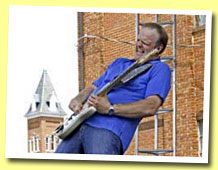 |
MALT
MANIACS INFORMATION
- MEGA KING SIZE REPORT |
SPIRIT
OF SPEYSIDE WHISKY FESTIVAL
- AUTUMN 2006
by MM correspondent
Bruce Crichton |
That’s
another Spirit
of Speyside Whisky Festival
over and done with and
here is my account of
it. My mission, at the
start of each festival,
is to ensure that every
dram that comes my way
is ruthlessly obliterated.
Because of this, I apologise
in advance for any factual
errors in my report
as I am relying on scribbled
notes and a memory made
hazy by my mission,
one in which I have
never failed. (Indeed,
the Titanic will raise
itself on the day that
I do fail.)
All of the views expressed
on the whiskies available
are a reflection of
my own ability to nose
and taste. Again, I
must caution the reader
that I am to articulate
tasting notes what the
Venus de Milo is to
heavy metal drumming.
The sharp-eyed reader
will also notice the
repetitive nature of
my descriptions of the
heavily sherried whiskies
on offer. My notes are
misleading, in this
respect, as the differences
between each of the
whiskies were considerable
but the same flavours
were all present, albeit
in varying degrees. |
My
friend and I began the
long weekend by taking
the bus tour to the
now independently-owned
Benriach distillery
where Stewart Buchanan
was to be our guide.
Stewart gave us an in-depth
and highly technical
tour of the distillery,
which has been in continuous
operation since 1965
and was sold off by
Pernod Ricard in 2004.
Stewart’s knowledge
was to be tested to
the full by some inquisitive
members of our party.
During the tour, Stewart
explained that the distillery
opened in 1898 and closed
in 1899 but its’
malting remained in
operation, supplying,
amongst others, it’s
neighbour Longmorn.
|
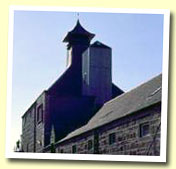 |
Stewart
took us through the
process from start to
finish and noted that
the barley is peated,
for certain runs, to
35 ppm and that the
water source for the
distillery is the same
as Longmorn. He also
added that extra stills
had been added during
a 1985 refit by, then
owners, Chivas Brothers.
In an unusual twist,
we had the chance to
smell some old, empty
casks, that had been
ex-sherry or ex-bourbon
(used to mature the
peated spirit). There
was a Tokaji wine barrel
that was empty but had
not been used -a lucky
escape as the wine had
gone off and the nose
was decidedly acidic.
We were informed that
about 10 percent of
the whisky is used for
single malt bottlings
and the rest is used
for blending, presumably
a large part going to
Chivas Regal. We headed
to the dunnage warehouse
where we viewed some
wine casks set aside
for limited edition
bottlings and Stewart
explained that the owners
were examining the possibility
of re-opening the maltings
which had remained in
perfect working order,
despite not being in
use.
We rounded off our tour
with a nosing of three
cask strength samples
before tasting the peated
10-year-old ‘Curiositas’
bottling. We thanked
Stewart for our tour
and headed next door
to Longmorn. |
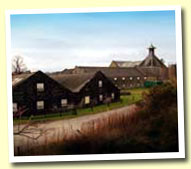 |
Our
host at Longmorn
Distillery
was Ann Miller, International
Brand Ambassador. By
contrast to it’s
neighbour, Longmorn
was established in 1894
and has remained open
since. Ann explained
that Longmorn gained
a reputation for quality
amongst master blenders
very quickly, within
a few weeks, in fact.
Like Benriach, the maltings
is not in operation
but, unlike Benriach,
there are no plans to
restart malting barley,
as it is a time-consuming
and laborious process.
The distillery prefers
to buy in barley from
a professional maltster
with the peat levels
being kept very low.
|
Heading
through the distillery
we discovered that Longmorn
had switched to metal
washbacks 10 years ago,
for ease of maintenance
and that the wash stills
are tall and wide-necked,
which helps to make
the spirit rich and
full-bodied. The stills
are also larger than
Benriach’s and
produce 3.5 million
litres of alcohol per
year. The distillery
is working at full capacity
and has been since Pernod
Ricard bought over Chivas
in 2002. The percentage
of whisky used for single
malt is variable but
there are plans for
some new expressions
in the near future.
Ann explained, however,
that we will never see
an 18 year old official
bottling as a large
quantity of Longmorn
goes into the Chivas
Regal 18 year old blend
– a sad end for
such a glorious whisky,
but that’s another
story.
The fun really began
as Ann took us through
our masterclass. After
smelling the clearic,
we had an 8-year-old
sample, at 58%abv, from
an ex-bourbon cask that
tasted of vanilla and
cereal with a slightly
syrupy finish. A tasting
of whisky from an 8-year-old
hogshead – a barrel
which contains new wood
staves and which had
the effect of freshening
the whisky slightly
and giving it a more
pronounced vanilla flavour,
followed this. Next
was the 15-year-old
official bottling, at
45%abv. The colour indicated
that most of the whisky
had been matured in
ex-bourbon casks with
only a slight sherry
influence discernible.
This was deliciously
sweet and malty with
a well-developed body
and a long creamy finish.
After this, we tasted
a 1969 vintage which
had more of the same
flavours but which was
incredibly smooth and
didn’t require
the addition of water.
Ending the class was
a 17 year old 2 cask
bottling, at 58.3%abv,
which is part of a range
of bottlings available
from Chivas distillery
shops.
While we were tasting
the final dram, Ann
discussed the fine art
of whisky blending with
us, noting that Longmorn
will form a large part
of the Royal Salute
blends. By this time,
the tour was over-running
slightly so we bade
Ann farewell and Mike
Hendry took us back
to Dufftown. |
| After
a respite, we headed
to Susan Webster’s
Douglas Laing
talk and taste, where
we had four unchillfiltered
bottlings from the Old
Malt Cask range, at
50% abv, and one from
the Provenance range,
at 46%abv. We opened
with a 1982 Saint Magdalene,
a lowland distillery
that closed in 1983.
This whisky was matured
in a second fill bourbon
cask. Susan described
it as a breakfast whisky
to go with crumpets
and butter and I found
to be dry and slightly
sharp with vanilla being
the dominant flavour. |
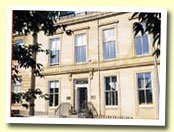 |
This
was an interesting chance
to try whisky from a
long gone distillery
and was a good starter
for the session.
Second was a 1985 Macallan,
matured in a refill
bourbon hogshead. In
the view of Douglas
Laing, these refill
bourbon casks ensure
that the maximum amount
of distillery character
is retained in the bottling.
This one was chewy and
had a taste somewhere
between walnuts and
hazelnuts. The nose
was spicy and the finish
smoky and long. At this
point, the talk really
picked up. To keep a
fresh palate, Susan
was taking only sips
of her whisky and adding
only a little water
before throwing her
drams into my bucket.
I very kindly stepped
in to relieve Susan
of this heart-breaking
job and polished off
her Macallan and the
other drams as well.
A Provenance Blair Athol,
from 1994, followed
and this was matured
in a sherry cask. It
was rich and sweet and
tasted of syrup, honey
and toffee. It also
didn’t have the
sharp and general Bell’s
character of the distillery
bottling. As we were
tasting, Susan explained
that the Provenance
range states the season
in which the whisky
was distilled. The idea
behind this is that
many whisky experts,
Susan’s father
included, believe that
the season affects the
whisky distillation
and the whisky distilled
in winter is heavier
than that distilled
in summer. I finished
mine quickly and made
a mental note to buy
a bottle as soon as
possible.
Our next dram was an
amazing 1979 Glen Rothes
which had spent 27 years
in a first fill sherry
cask and a few months
in a Madeira cask. The
tasting notes on the
bottle described it
as ‘attractively
unusual’. Taken
neat, this whisky was
smoother than a smoothfish’s
smooth bits, after it
had been put through
a smoothing machine,
ironed till it’s
nice and smooth and
then fed to the man
who taught Roger Moore
how to be smooth (and
that’s dead smooth).
It tasted of sherry
trifle, toffee and wedding
cake with a liqueurish
finish. Susan explained
that this was a serendipitous
bottling as it had been
transferred to a Madeira
cask in the mistaken
belief that it had been
matured in a bourbon
cask. Susan and I later
discussed the similarity
between this and a 1979
vintage from the same
distillery in Douglas
Laing’s Platinum
range, featured in the
Autumn 2005 festival,
and we wondered if there
would have been any
detectable difference
between the casks if
they had both been bottled
at the same age and
strength.
Finally we had a 1991
rum-finished Ardbeg
which had a pungent,
phenolic nose but which
was surprisingly light
to taste. Whisky festival
regular Phil Yorke,
sitting next to me,
described it as tasting
like a ‘soft,
smoked Bavarian cheese’
which was a lot better
than the rubbish I had
written so I went with
his description and,
when the session ended,
I filed it under ‘Mmmmmm!
Seconds!’ |
On
Saturday, Mike Lord
took our first talk
and taste of the day
and we went on a supermarket
sweep. As we
began, Mike said, to
much laughter, that
the point of this event
was to make sure that
we never buy supermarket
whiskies again and save
our money for quality
whiskies like the ones
stocked by his shop.
Also, the idea was that
we should try to guess
which single malts were
in these supermarket
bottlings as Mike had
contacted the supermarkets,
himself, for information
and had received only
bland, nondescript drivel
in response.
First was a 12-year-old
Speyside from Waitrose.
This had vanilla on
the nose but was bitter
to taste and the finish
was short and unremarkable.
Steve Oliver suggested
that we shouldn’t
rule out Angus Dundee
distillers as the suppliers
for this whisky and
if they are, then on
this evidence, they
are keeping all the
good casks for themselves.
Much more promising
was Asda’s 12-year-old
Speyside, which had
a sweet nose and a spicy,
slightly sweet palate
with a winey finish.
This bore a striking
resemblance to Glen
Moray, in the view of
most of the tasters.
Sainsbury’s 12-year-old
Speyside had a non-existent,
sphinx-like, nose but
a very sweet palate
and a tangy, peppery
finish, though none
of us could really guess
which distillery it
came from.
Asda’s 12-year-old
Highland had sherry
and honey on the nose
and taste with lots
of chewy sweetness and
a long, chocolate finish.
Mike suggested that
this could be Dalmore
and not many disagreed
with him.
We ended on a light
note with Tesco’s
Glen Ranoch Highland
malt, which is extremely
cheap, and Mike had
everyone in stitches
as he read out the notes
on the bottle which
were clearly written
by someone with a severe
hallucinogenic drug
problem and were aimed
at the customer who
has no idea about whisky
and who intends to drown
their whisky with a
fizzy drink. In it’s
favour it was smooth
and had no off-notes
but the only taste any
one could get was caramel
and, judging by it’s
rich colour, there had
been plenty of it added.
No one had the faintest
idea what distillery
this could have come
from.
Rounding the talk off,
Mike said that the second
purpose of this session
was to find out if there
were any genuine gems
amongst supermarket
whiskies and we all
agreed that Sainsbury’s
own was excellent. I
also thought both the
Asda bottlings weren’t
far behind. |
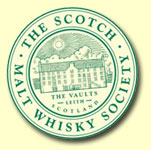 |
Being
a fully paid-up member
of the ‘I like
food, food is good’
school of thought (anyone
who has seen me from
sideways on can confirm
that this is true),
the whisky and cheese
event taken by Annabel
Meikle of the Scotch
Malt Whisky Society
was not be missed.
As we started, Annabel
explained that she gained
a thorough knowledge
of cheese from years
of working in a delicatessen
and that she began working
in the bar of the SMWS
and now looks after
corporate membership.
On our plates were 5
slices of cheese, oatcakes
and a mysterious substance,
which turned out to
be honey. |
We
also were given a pamphlet
detailing the whiskies
we were going to be
having and the cheeses,
all of them small batch
cheeses made from unpasteurised
milk.
As we tasted our first
whisky, an 18-year-old
Glenkinchie at 52%abv,
Annabel told us that
lowland whiskies complement
creamy cheese and we
were having Flower Marie
cheese, made in East
Sussex. Tasting cheese
and honey together,
for the first time,
I commented “Mmmmm!
Dat’s de best
food in de world evvah!”
(Talking with your mouth
full is a very bad idea).
The whisky and cheese
complemented each other
wonderfully and the
Glenkinchie was dry
and tasted of lemon
and citrus.
Next up was another
lowlander, Bladnoch
13-year-old at 59.21%abv,
and Ragstone Log goat’s
cheese. Again, the cheese
was creamy and delicious
and the whisky was peppery
neat and opened up,
on reduction, to reveal
syrupy sweetness on
the palate and a peppery
finish. The third combination
was a 16-year-old Aultmore,
at 56.6%abv, and Criffel
– a soft cows
cheese made from organic
milk in Dumfries, in
the Scottish borders.
Neat, the Speyside whisky
was soft, sweet and
smooth and tasted of
biscuits. The cheese
was older and heavier
and was tangy and herbal
to taste. A 36-year-old
Longmorn, at 52.1% abv,
was very heavily sherried,
an interesting contrast
to the previous day’s
bourbon cask offerings,
and the nose was very
sweet. The accompanying
cheese was a Mimolette
cows cheese from Northwest
France. The cheese was
rock hard but melted
in the mouth. The whisky
didn’t change
too much with water
and was extremely sweet
and tasted of very rich
toffee and fudge –
a genuine delight.
Finally came our heaviest
dram, a 25-year-old
Caol Ila at 56.5%abv,
and the cheese was a
Dunsyre Blue made from
cows milk in the Pentland
hills, near Edinburgh,
which tasted both sweet
and peppery. The Caol
Ila was surprisingly
floral to nose and was
lightly smoky and salty
to taste, with a peppery
finish and rounded off
an exciting and informative
talk in superb fashion.
After this, a trip to
the Scott’s restaurant,
at the Tannochbrae
hotel, was in order,
as it is for any member
of the school of thought
I mentioned earlier.
|
| Again,
Allan and Susie served
up a series of delightful
courses, each accompanied
by a whisky supplied
by Duncan Taylor and
co and a story from
Ricky Christie, formerly
of the North of Scotland
Distilling Company.Once
again, Ricky demonstrated
his oratorical prowess
with a series of tales
about his father, Whyte
and Mackay’s Richard
Paterson, blizzards
during the Speyside
Distillery’s first
firing of the stills
and breaking ice with
golf clubs, tastings
at St. Andrews University
and throwing whisky
in the fire (this is
very ill-advised, Ricky
assures us). |
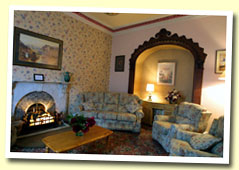 |
During
an interlude, Ricky
also gave us the chance
to taste a new project
of his entitled ‘VALT’
– vodka made from
malted barley. Though
not a vodka drinker,
I found this to be smooth
and pleasant and not
at all deserving of
death by carbonated
soft drinks. The meal
continued and Ricky
had more stories to
tell of lost Americans
in the Cairngorms, drunken
chauffeurs, ‘Willie
the watcher’ and
his Asian successor,
and of the ‘Horse’s
Neck’ –
a sure-fire hangover
cure.
As for the whiskies
which accompanied the
meal, of particular
interest were a Whisky
Galore Rosebank 12-year-old
which was light, fruity
and floral and a 1996
bourbon cask Macallan
which was smooth, fresh,
vanilla-sweet and left
the official ‘Fine
oak’ bottling
eating it’s dust.
A 1969 Macduff was extremely
heavy and thick tasting
of sherry, toffee and
fruit-cake and freshened
considerably on addition
of water and a 1992
Caol Ila 13-year-old
had a pungent nose but
an unexpectedly light
taste and a crisp finish
and was an excellent
choice for a nightcap. |
| Sunday
began with a trip to
Knockando estate with
the multi-talented Mike
Hendry as our driver.
On the way, Mike demonstrated
his in-depth knowledge
of the local area and
we then disembarked
to commence our walk
along the Speyside way
with David Newlands
as our guide. David
is a wildlife expert
and we enjoyed a fine
morning’s walk
over the water supply
for the Tamdhu, Cardhu
and Knockando distilleries,
stopping to sample the
official, no age statement,
bottling of Tamdhu.
|
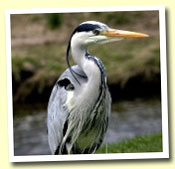 |
Our
walk continued and David
enlivened our walk with
his knowledge of local
flora and fauna as we
passed numerous trees,
various types of berries
used for making gin,
jelly and syrup, plants
used as eye medicine,
food flavouring and
insect repellent. On
the way, David pointed
out a heron, in the
Spey, and we were able
to view it, from distance,
using his equipment
and, also, a dipper,
which is a bird unique
to fast highland rivers
which survives by eating
stonefly larvae. David
also noted that, had
we been here in centuries
gone by, we would have
been under water, in
the Knockando glacier
lake. |
| We
continued our walk past
the Imperial and Dailuaine
distilleries, pausing,
in-between, to taste
a rare official bottling
of Imperial, at 15 years
old and 46%abv, and
some Walker’s
shortbread. We then
reached Aberlour, our
destination, and headed
to the Old Pantry Restaurant
for lunch, where I heartily
recommend the turkey
broth. Thanks to David
for a fine morning’s
entertainment. |
Heading
to the Whisky Museum
again, we arrived in
time for Alex Bruce,
of Adelphi,
who was conducting the
talk and taste session.
Alex gave us a brief
history of the original
Adelphi distillery which
was in the Gorbals area
of Glasgow but closed
in the early part of
the 20th century after
a disastrous collapse
of it’s washbacks.
The name was later bought
over by an Edinburgh-based
bottler and then the
company changed ownership
recently and moved out
to Ardnamurchan, in
the west highlands of
Scotland, where popular
whisky writer, Charles
MacLean helps to select
the casks. Each of Adelphi’s
single cask bottlings
are unchillfiltered
and always at cask strength
so that, in Alex’s
view, the customer can
decide which strength
is best to taste at.
|
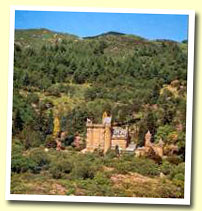 |
The
packaging is also quite
minimalist in order
for the customer to
view the natural colour
of the whisky in the
bottle.
As we began our first
dram, Alex explained
that many distilleries
do not like their name
appearing on independent
bottlings and, so, Adelphi
have brought out the
‘Breath of’
range which specify
only the region on the
label. We tasted a 1985
‘Breath of Highlands’
at 55.1%abv, which Alex
joked could have been
named ‘Breath
of Deeside’, and
I found it to be very
sweet with strong flavours
of syrup and honey.
Water freshened it and
opened up tastes of
apples with a hint of
coconut.
Alex explained that
Adelphi bottle 3 to
4 times per year as
we moved on to a 1991
Tamdhu, at 60%abv. This
was matured in a sherry
cask and tasted of chocolate
with a velvety finish.
As we were tasting,
Alex said that the company’s
whiskies are in such
high demand, relative
to supply, that it’s
not unusual (as Tom
Jones would say) for
bottlings to be sold
out within minutes of
release.
Next up was a rare chance
to taste Glen Scotia,
from Campbeltown, a
distillery very much
in the shadow of it’s
illustrious neighbour,
Springbank, and which
is very infrequently
seen in independent
bottlings and is, apparently,
even less frequently
to be found in good
independent bottlings.
This 1991 cask, at 61.6%,
was absolutely brilliant
and was dangerously
smooth when taken without
water. The nose and
taste were both of vanilla
and peat and a slight
addition of water revealed
sweetness and some light
smokiness. (Even better
was when Swedish chocolate
expert Paul Martensson
gave me his to finish.
Result!)
We then had a virtually
opaque 1980 Inchgower,
at 60.4%abv. This had
previously made an appearance
at the Spring festival’s
independent bottler’s
challenge event. Without
adding water, this one
was so smooth that I
wish I hadn’t
used all my superlatives
earlier in the report
(I must invest in a
thesaurus). The whisky
was strong in that it
didn’t collapse
on addition of water,
like some sherried whiskies
can do and it tasted
of toffee, fruitcake
and cake icing. Interestingly
Alex suggested that
it would go with dark
chocolate and Paul Martensson
stepped up to supply
him with some.
Alex told us that they
had another Inchgower
cask, also heavily sherried,
from the same vintage
but which, in his view,
was overdone and had
become rubbery and sulphurous
to taste. However, it
had proved popular in
Germany, where these
flavours are welcomed
in a whisky.
Between drams, Alex
revealed that whiskies
can sometimes gain alcohol,
by volume, depending
on where they are matured,
noting that he had tasted
a cask at 66%abv. He
said that an Islay whisky
matured on the island
is rarely more than
56%abv while a cask
matured on the mainland
can retain it’s
alcohol or even gain
strength, in percentage
terms. Accordingly,
we closed the session
with a chance to taste
a 1984 Caol Ila, which
had not yet been officially
bottled. This was at
59%abv, suggesting mainland
maturation, and had
a lightness of nose
and taste that one would
associate with whisky
half this age. Again,
it was smooth before
reduction and water
revealed a taste of
smoked sausage with
pepper on the finish.
Thanks to Alex for a
great tasting and anyone
who is able to obtain
a bottle of one of these
whiskies before they
inevitably sell out
will surely not be disappointed. |
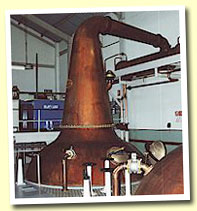 |
After
a day of relative rest,
Monday began with a
bus trip to Glenallachie
distillery,
just outside Aberlour.
Our guide was to be
Dennis who gave us a
lively, fascinating
and jovial history of
the distillery that
was built in 1967 and
was owned by Mackinlay-McPherson
and was associated with
the Original Mackinlay
blends. The distillery
was bought over, and
promptly closed, by
Invergordon distillers
in 1985 but re-opened
in 1989 when bought
over by Campbell distillers,
who have since become
Pernod Ricard. 2005
was a record year for
spirit production, 2.8
million litres of alcohol
as compared to 3 million
at Aberlour. Dennis
also reckons that the
distillery is ripe for
expansion. |
Dennis
joked that when Glenallachie
was bought over, the
ducks in the pond cost
more than the distillery
did and, as if on cue,
the ducks appeared and
waddled across the car
park. As we went through
the whisky-making process
we looked in to the
washback where Dennis
told us that a man had
fallen in and taken
3 days to drown as,
every time he was pulled
out, he jumped back
in again. The wash stills,
Dennis informed us,
were the biggest in
the Pernod Ricard group,
which includes Chivas
brothers.
Bringing an entertaining
tour to a close, Dennis
broke open a single
cask bottling, at 57.8%abv,
which had sherry character
for all to see and which
Dennis described as
having ‘longer
legs than Betty Grable’,
a quote well worthy
of using in this report.
To my mind, the nose
was prickly, as if it
had been matured with
a hedgehog in the cask,
and the whisky had a
full body and was very
smooth, despite it’s
high strength. A slight
addition of water revealed
it to have fruitcake,
syrup and toffee on
the palate and Dennis
told us that this bottling,
like Friday’s
Longmorn, was only available
in distillery shops
owned by Chivas brothers.
Thanking Dennis for
a great tour, we bade
him farewell and festival
regular Dr Stephen Lunn
managed to bring the
remainder of the bottle
back for the dregs party.
We headed round Benrinnes
to our next port of
call, Glenfarclas
distillery
where Ian McWilliam
was to be our guide. |
Ian
told us, as we began
our tour, that the distillery
was established in 1836
and was bought over
by John Grant and has
remained in the Grant
family’s ownership
ever since and is now
in the 5th generation
of Grants to own Glenfarclas.
Glenfarclas takes its’
water from ‘the
green burn’ off
Benrinnes hill and the
distillery has exclusive
rights to the water.
The distillery uses
lightly peated Optic
barley and is currently
running at about 75%
of production, though
it is hoped that there
will be a period of
full production in 2007. |
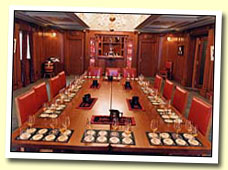 |
We
continued through the
distillation process
where Ian showed us
the expensive five roll
mill, used to crush
the barley and the de-stoner,
both Swiss-made, and
which have never failed
since it’s installation
in 1974. Glenfarclas
has the largest stills
in Speyside and they
are directly fired,
which is unusual. An
experiment was carried
out with the more usual
steam coils but the
spirit was unrecognisable
and direct heating was
re-introduced.
As we viewed the warehouse,
Ian told us that in
Glenfarclas’ view,
first fill bourbon casks
influence the maturation
process too much, so
they use second fill
casks together with
first fill Spanish Oloroso
sherry casks, personally
selected by the Grant
family. Our highly informative
tour, full of interesting
titbits came to an end
and we moved on to our
masterclass which had
the added bonus of two
extra drams of whiskies
usually sold abroad.
As we nosed and tasted
a surprisingly sweet
clearic sample, Ian
explained that Glenfarclas
do not chillfilter any
of their range and then
handed round cask strength
10-year-old samples
from bourbon and sherry
casks to nose and take
a small taste of. The
sherry cask was incredibly
dark for such a young
age - the David Dickinson
of whisky. We opened
with the 10-year-old
version, which was slightly
sharp and toffee-sweet
with an aperitif quality
about it. The export-only
12-year-old, at 43%abv,
was next and had more
obvious sherry character
and was sweeter and
more syrupy than its'
younger brother. The
15-year-old, at 46%abv,
was in a darkened bottle
as consistency of colour
is apparently hard to
obtain. This had good
‘legs’ and
a mouth-coating feel
with a rich, smoky and
velvety finish. By comparison,
the export-only 17-year-old,
at 43%abv, was very
light and had more vanilla
and was fresh, perhaps
indicating more bourbon
and second-fill sherry
maturation as Glenfarclas
matures it older whiskies
in refill sherry casks.
The 21-year-old (43%abv)
was lighter still, in
colour, and was very
fresh and lively tasting
much younger than its’
years would indicate.
The 25-year-old version,
again at 43%abv, was
dryer and softer and
tasted of vanilla. It
was best neat and would
make a good nightcap.
The 30-year-old had
more sherry character
and tasted of dark chocolate.
Again, it was a lot
lighter than one would
expect given its’
age. Finishing the class
was the 105 proof bottling,
which is ten years old,
despite having no age
statement on the bottle.
This was fruity on the
nose and palate and
dangerous to have with
taste buds already warm
with it’s more-ish
qualities and high strength
surely leading to alcoholic
oblivion, if one is
not careful. As we were
finishing our drams,
Ian told us to watch
out for a series of
vintage bottlings, of
casks from every year
between 1952 and 1997,
to come in the near
future. These will be
called the ‘Family
Casks’ with a
new, exclusive, bottle
being created for the
purpose.
Thanking Ian for a fantastic
tour and class, we headed
for home, considerably
more boisterous than
we had been when we
set out and we must
have given a new meaning
to the word ‘cacophonous’
to any one who had the
misfortune to hear us. |
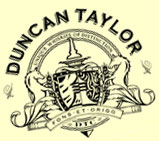 |
Allowing
sufficient time for
the world to stop melting,
we headed to the final
talk and taste of the
festival where ‘Bad
boy’ Mark Watt
presented us with a
selection of unchillfiltered
bottlings from Duncan
Taylor. (Rumours
that Keith Richards
routinely chides Mark
for living far too fast
are neither confirmed
nor denied.)
A 1994 Whisky Galore
Imperial, at 46%abv,
was a good opener, with
an acidic nose and it
tasted mostly of vanilla
with a very creamy middle
and finish. Comfortably
the best independent
bottling of Imperial
to be had. |
As we tasted a 1980
Knockando from the
‘Rare Auld’
range, at 48.3%abv,
Mark explained that
this range was previously
called the ‘Peerless’
range but they decided
to change it ‘s
name. The reason being
that another company
had used the name
‘Peerless’
and the grandson of
infamous gangster
Lucky Luciano owned
them. Knockando is
not commonly seen
in independent bottlings
and this was light
and had a vanilla
taste with a fresh
and winey finish.
A 1970 Glen Rothes
from the Lonach Range,
at 40.3%abv, offered
a relatively inexpensive
chance to sample old
whisky. In this case,
a vatting of 2 casks
which had fallen to
a very low alcoholic
strength. This one
was delicate and tasted
of wine. As we tasted,
Mark told us amusing
stories of hiding
in the Macallan warehouse
and eavesdropping
on Charles Maclean.
Mark also thought
that some extra alcohol
would have improved
this whisky.
A 1981 Glenugie, from
the ‘Rarest
of the rare’
range at 61.9%, was
the last heavily sherried
dram of the weekend,
from one of the many
distilleries culled
in 1983. Mark joked
that the high strength
was because the cask
had been wrapped in
Clingfilm. It was
very light and tasted
like a much younger
whisky but water revealed
some rubbery notes
and this cask was
probably past its'
peak. Just to show
that one man’s
meat is another one’s
poison, an American
gentleman was so impressed
that he asked to try
it again at the end.
Mark described this
as like ‘Pickled
onion Monster Munch’;
the best tasting note
ever made.
We ended with the
vatted malt ‘Big
Smoke 60’ at
a self-explanatory
60%abv. Despite it’s
name, it was delicate,
sweet and not especially
smoky and Mark told
us of going for drinks
with his schoolteacher,
when he was 18 and
still at school, as
we finished our drinks.
The festival was brought
to a close, as always,
with the dregs party,
in the Whisky Shop.
Abandoning any attempts
at tasting notes,
we picked off stragglers
from previous tasting
events such as a Provenance
Ardmore, a Whisky
Galore Mortlach, a
Serendipity (Glen
Moray and Ardbeg),
an Old Malt Cask Glentauchers
and an official bottling
of Ardmore. This dregs
party was a well-behaved
affair and it was
knocked on the head
at a civilised hour
and everyone went
home.
Finally, I’d
like to thank all
of those involved
in organising and
running the festival
and, in particular,
Mike Lord, Steve Oliver,
Georgie Crawford,
Mike Hendry, David
Newlands and Allan
and Susie at the Tannochbrae.
I hope to see everyone
again in May 2007.
- Bruce Crichton |
|
|
|
|
October
24, 2006 |
|
 |
CONCERT
REVIEW by Nick Morgan
HELLWOOD The
Mean Fiddler, London, October 18th
2006 |
| Guitar
cradled in his arms, the tall, angular
and slightly awkward Jim
White leans down towards
the microphone and announces in
his nasal southern burr, “We’re
Hellwood, and London, we’re
here to blow you away …..err….in
a minute …You ready Johnny?”
To the left of the stage the small
and stocky Johnny
Dowd is fidgeting with
his guitar, stubbing out a cigarette
and winning admiring glances for
his Travoltaesque shirt. And were
it not for the fact that these two
share an obsession with the darker
things in life, both of them masters
of what might be called alt.country
faux-gothic god-soaked gloom, you
might wonder what they are doing
on the same stage. Orange juice
drinking Jim lightens his noir with
a wistful humour, a deep sense of
love and subtle musical complexity,
and he’d rather be at home
changing the nappies of his new
two month old daughter than trapped
in one corner of the Mean Fiddler
stage. “If Johnny Dowd didn't
exist, Quentin Tarantino would have
had to invent him” said London’s
Evening Standard. Whisk(e)y drinking
roll-up smoking Dowd (“in
fact I’d drink just fucking
anything you gave me at this moment
in time”) gives the impression
of being a taut bundle of latent
aggression (an impression supported
by constant references to the fight
he’s supposed to have had
in Glasgow the previous night).
He’s in a confrontational
bluesy punk-rock mood – and
in his dark world (“Johnny
Dowd – the kingpin of sin”)
there’s no room for humour
(until, that is, he melts into a
huge smile - which to be honest
he does at the end of each song).
|
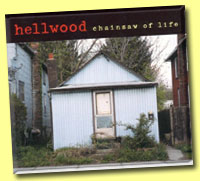 |
|
|
Yet
these two clearly have a deep rapport
and considerable mutual respect
(“Did I tell you about my
cock?” goes a hypnotic and
repetitive refrain to one of Dowd’s
songs, “Well yes Johnny, actually
you did, quite a lot” intones
White by way of reply). So much
so that they’ve made an album
together, Chainsaw of Life, under
the name of Hellwood, with fellow
Dowd collaborator Wille
B, drummer and bass-pedal
player extraordinaire. It’s
a characteristically dark affair,
almost perhaps too sombre, which
to be honest needed this performance
to bring it to life. |
| Tonight
the three of them are on stage,
along with organist Michael
Stark. The Mean Fiddler
is pretty full – mostly men,
mostly mid-thirties plus and mostly
big Dowd or White fans (or both).
It’s clearly not a place for
neutrals. Once Dowd sorts himself
out the band lash into ‘Alien
tongue’ and ‘Man in
a plaid suit’ – two
of the punkier songs from ‘Chainsaw’,
both sung by an animated White.
Willie B’s drumming is of
the Animal school, his organ pedals
producing a booming backdrop for
Dowd’s staccato guitar –
“now that’s what I call
rock and roll” mutters Dowd,
clearly warming up as he drawls
his way through ‘God’s
back pocket’ – “I’m
a human stain on everything divine
… a Romeo of spiritual deviance”,
supported by White who’s using
a child’s toy to distort his
voice. In the course of the evening
they play the entire album and by
and large the songs get better and
stronger as they go on. There are
some obvious winners, ‘A man
loves his wife’ (“You
know a friend of mine heard that
song and said Jim, you’ve
written a real beauty there, but
I had to tell him that my muse Johnny
Dowd wrote most of the words”)
and the sharply ironic Katrina-inspired
‘Thank you lord’ –
another monotone Dowd vocal. But
a couple of songs that didn’t
seem to perform on the CD are real
surprises here – ‘Firework
factory’ (with a surprisingly
agitated ending from Jim White)
and the simply superb slow groove
‘Thomas Dorsey’, which
unless I’m mistaken Dowd hijacked
with lyrics from his song ‘No
woman’s flesh but hers’.
The house is truly rocked –
especially by ‘Spider in the
room’ a really danceable and
funny tune written by White. “I’ve
got fucking spiders in my head”
shouts the swaying drunk next to
me in a moment of absolute silence.
“Hmm” says Jim, “sounds
like you need some of that mental
insecticide”. Jim’s
right. We move. |
| “This
is one of the moments everyone in
the band likes best” says
Dowd, as White steps forward to
sing ‘God was drunk when he
made me”. White later tells
a characteristically convoluted
story about a theological confrontation
with country star Sleepy
LaBeef provoked by the song
as an introduction to ‘A bar
is just a church where they sell
beer’, a solo performance
that helpfully allows Dowd to recharge
a glass or two. It’s during
this song that we all notice that
the lighting rig on the ceiling
is shaking with a frightening degree
of fury, Poltergeist style –
“Is that you Sleepy?”
asks White, “Is that you Lord?
Are you angry?” Actually it’s
the Kooks – or their gyrating
teenage fans - who are playing upstairs
in the Pickle Factory, but the dramatic
effect is wonderful. A refreshed
Dowd returns to introduce, to everyone’s
bewilderment, a ZZ Top medley, performed
by Willie B and Stark (I think you
can find it on the album they’ve
just released) before playing a
heavy duty version of his own ‘Ding
dong’, and while White gets
almost all the toys out of his percussion
toy box, Dowd manages, as he has
done a number of times earlier,
to sing, smoke, drink and play guitar
at the same time – a truly
inspiring accomplishment. |
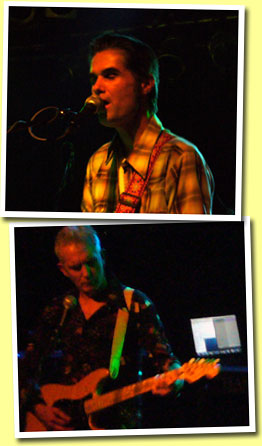
Jim
White and Johnny Dowd
|
| And
after almost two hours they finish,
‘though Dowd is looking as
though he’s in the mood to
carry on all night. Instead, along
with Willie B and Jim he sets up
the merchandise store where they
happily chat to their adoring fans
– while a few wait patiently
as Michael Stark burns them CD’s
of the evening’s gig which
he’s taken as a live feed
from the mixing desk. Now there’s
a first. - Nick Morgan (photographs
by Kate) |
| Many
thanks Nick, I must say I didn’t
know Johnny Dowd before, very idiosyncratic
to say the least. There's some interesting
music on his myspace
page (but what would we do without
myspace???) Good music as well by
Willie B. and Michael Stark on their
Tzar
page but then again, every time
I hear Hammond, I melt... I just
hope I won't melt too much at Brian
Auger next month. - Serge |
| TASTING
- ANOTHER TWO BRILLIANT OLD BOWMORES |
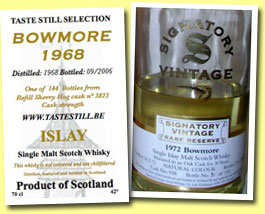 |
Bowmore
1968/2006 (41.5%, The Taste Still,
cask #3823, 144 bottles, Belgium)
 Colour: straw with bronze hues.
Nose: a superb fruity attack as
(almost) usual with these old
Bowmores but this time there’s
also a little peat coming through,
as if all the peat hadn’t
been ‘aromatically converted’.
That does give this version an
extra-dimension. Lots of pink
grapefruits, passion fruits and
mangos plus hints of vodka-orange,
orange drops, tangerine liqueur
and lemon balm.
Colour: straw with bronze hues.
Nose: a superb fruity attack as
(almost) usual with these old
Bowmores but this time there’s
also a little peat coming through,
as if all the peat hadn’t
been ‘aromatically converted’.
That does give this version an
extra-dimension. Lots of pink
grapefruits, passion fruits and
mangos plus hints of vodka-orange,
orange drops, tangerine liqueur
and lemon balm. |
|
A beautiful sharpness, quite unusual
in these old Bowmores. It develops
on various kinds of fresh herbs
(parsley, dill, celery), with also
something slightly wild and farmy
(hay, smoked ham). Lots of presence,
ending with quite some lemon juice
and some great oaky tones. A tireless
old Bowmore, brilliant. Mouth: the
attack isn’t exactly powerful
but rather ‘wide’, with
the expected bitter oranges, grapefruits
and lemon zests. A very pleasant
bitterness (walnut skin, apple skin,
dried ginger) mingles with all sorts
of herbal teas and something waxy
and rather resinous. Less complex
on the palate than on the nose but
still very expressive and pleasant.
Medium long finish on quince jelly,
bitter oranges and quite some salt
remaining on your tongue and lips
for a long time. Another excellent
1968 Bowmore, very interesting because
it’s a little less of a fruitbomb
than many of its twins. 93
points. (correction:
this one has been finally labelled
using a regular Duncan Taylor Rare
Auld label, not the dummy white
label - thanks Kirsty) |
Bowmore
30 yo 1972/2002 (50.3%, Signatory,
cask #928, 192 bottles)
 Colour: white wine, amazingly pale.
Nose: this one is much sharper and
spirity, an also rather less expressive
at first try. Much more austere
but also peatier and more mineral
(chalk but also aspirin) as well
as rather vegetal (grass). It gets
peatier and peatier with time, in
a beautiful way. Lots of fermenting
hay, beer, sour cream, myrtle liqueur,
celeriac, dried kelp… Gets
much smokier as well, with also
notes of torrefaction, cappuccino
and smoked tea. How great, although
completely different from the 1968.
Mouth: a stunning attack, with more
fruits now (grapefruits, crystallised
oranges, kumquats) and lots of salt
right from the start. We have also
a big, bold peat (okay, not like
in Ardbeg but we aren’t that
far) and lots of ‘coastality’.
Oysters, kippers, anchovies…
Really fantastic! A very long finish,
bold, punchy, very dry, salty, smoky
and citrusy… Another true
masterpiece from the shores of the
Loch Indaal, no doubt about that.
Probably more elegant and uncompromising
than most ultra-fruity and sexy
Bowmores from the 60’s. Maybe
that’s why I really loved
it, despite the slightly shy start:
94 points.
Colour: white wine, amazingly pale.
Nose: this one is much sharper and
spirity, an also rather less expressive
at first try. Much more austere
but also peatier and more mineral
(chalk but also aspirin) as well
as rather vegetal (grass). It gets
peatier and peatier with time, in
a beautiful way. Lots of fermenting
hay, beer, sour cream, myrtle liqueur,
celeriac, dried kelp… Gets
much smokier as well, with also
notes of torrefaction, cappuccino
and smoked tea. How great, although
completely different from the 1968.
Mouth: a stunning attack, with more
fruits now (grapefruits, crystallised
oranges, kumquats) and lots of salt
right from the start. We have also
a big, bold peat (okay, not like
in Ardbeg but we aren’t that
far) and lots of ‘coastality’.
Oysters, kippers, anchovies…
Really fantastic! A very long finish,
bold, punchy, very dry, salty, smoky
and citrusy… Another true
masterpiece from the shores of the
Loch Indaal, no doubt about that.
Probably more elegant and uncompromising
than most ultra-fruity and sexy
Bowmores from the 60’s. Maybe
that’s why I really loved
it, despite the slightly shy start:
94 points. |
|
|
|
October
23, 2006 |
|
 |
| CONCERT
REVIEW by Nick Morgan |
KEVIN
AYERS The
Arts Theatre, Soho, London, October
15th 2006
By
a strangely strange coincidence
there was an article
about Britain’s famous ‘Canterbury
scene’ of the late 1960s
and early 1970s in yesterday’s
Guardian, accompanied by a striking
photograph of a rather androgynous-looking
Kevin
Ayers in a Paisley-patterned
dressing gown. Ayers got one mention
in the piece, in the same breath
as Wilde Flowers, Soft Machine
(which he co-founded), Gong (Ayers
was a member for a year or so)
and Caravan (come on, everyone
remembers In the Land of Grey
and Pink). |
|
| No
room here for the “along with
Syd Barrett the most important artist
in the creation of the British psychedelic
movement” which you’ll
find in many books and articles,
or any consideration of his later
(or even current) career. You may
even have thought, that like the
recently and sadly departed Syd,
he was dead. No doubt that’s
partly (mainly?) because Ayers seems
to have spent most of his career
walking away from projects just
as they seemed to be becoming successful,
preferring instead (as some suggest)
a lazy and louche lifestyle in Spain
and France. |
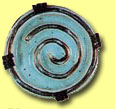 |
A
new album in the late 1980s (Falling
Up), and another in the 1992 (Still
Life with a Guitar) mark about the
whole of his recent original work,
although there’s little shortage
of reissued material and newly released
archive stuff from the BBC and others.
However he’s recording a new
album (Unfairground) and touring,
albeit briefly. And did you know
Serge, that he was awarded the Ordre
de la Grande Gidouille by your very
French Collège
de Pataphysique? |
| I
tend to buy concert tickets like
others buy books, in front of a
computer, after-dinner, with a glass
in my hand and a few magazines and
newspapers by my side. It’s
one of those habits that makes life
a wonderful lottery. So as we sat
in the middle of the front row of
the tiny and largely empty Arts
Theatre in the centre of Soho on
a Sunday evening when I could have
been at home enjoying a glass of
claret with some rare roast beef
and Yorkshire pudding, the thought
“what the hell am I doing
here?” was writ largely on
my mind. But we very much enjoyed
support act John
Redfern, a soulful voice, complex
and accomplished acoustic guitar
and a satisfying suggestion of the
Blue Nile all means that it might
be worthwhile looking out for his
forthcoming album May be Some Time.
And after his thirty minutes or
so the place did fill up with maybe
60 people or more, many of whom
looked as though they could well
have been Canterbury survivors,
although I’m not sure that
could be said of the inebriate immediately
behind us with the painfully loud
comedy shout (“Whey hey hey
heeeyyy”) that greeted the
start and end of every subsequent
song. No, he was just a pissed-up
moron. |
| Ayers
came to the stage with accompanist
Max la Villa, a versatile guitarist
who straddles both classical and
contemporary music (he’s worked
with Jah Wobble) with ease. He’s
also got good eyesight, which is
pretty crucial as the stage is almost
pitch black (could it be, we wondered,
that Kevin is trying to hide the
effect of time on those once beautiful
British public schoolboy features?).
Hence no photographs. Kevin can’t
see the set-list, and is reluctant
to wear his spectacles (more vanity?),
so it’s Max who calls the
songs. |
| And
now I’ll tell you something
– almost from the moment the
first song started the clock stopped
–in fact it went backwards,
and I swear the Arts Theatre just
for an hour or so was whisked through
a time-space continuum, or whatever
they’re called, to about 1970.
I suppose it could have been the
pataphysics, but the principle reason
was Ayers’ voice, that rich,
slightly posh, rather diffident,
somewhat regretful, somewhat ironic
and very knowing baritone. He didn’t
play the guitar too well, couldn’t
remember all the words, but he sang
like, well … Kevin Ayers,
and as you should know, it’s
one of the most unique voices in
contemporary music. We got about
fourteen songs (each of course accompanied
by an increasingly irritating “Whey
hey hey heeeyyy” from the
moron, who hadn’t, or so it
appeared, joined the rest of us
in the time warp) starting with
‘Too old to die young’,
and including ‘Eleanor’s
cake which ate her’, ‘I
don’t depend on you’,
‘Lady Rachel’ (perfect),
‘Blame it on love’,
‘Didn’t feel lonely
‘till I thought of you’,
‘Something in between’,
‘Whatever she brings we sing’
and a final, brief ‘See you
later’. |
| All
over in less than an hour, but perfectly
charming. And really the only conversation
centred on Ayers’ increasing
anxiety about the lack of alcohol
in his glass – “This
is not what I call a drink!”
he complained, displaying the bottle
of water that had been brought to
the stage when he complained of
thirst. “I know I really should
be talking but I really don’t
have anything to say except the
songs” he told us later, happy
with a large Scotch in his hand.
And not even a goodnight, just a
languid wave as the clock rushed
us back to the twenty-first century.
“Whey hey hey heeeyyy”!
- Nick Morgan |
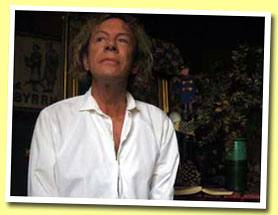 |
| Thank
you Nick, all the Canterbury/Soft
Machine generation has always been
quite hot here – both before
and after Robert Wyatt’s cult
LP Rock Bottom. Imagine we had a
(almost) neighbour who joined Daevid
Allen’s Gong in 1973 and eventually
became the band’s leader.
His name was Pierre
Moerlen, he was a brilliant
drummer and sadly, he passed away
last year. But back to Kevin Ayers
and his bananas and mananas, with
this great page
you passed me, where our distinguished
readers will find an mp3 of a whole
2006 gig he played at London’s
Cobden Club, please check the 'audio'
page. And oh, yes, we also have
the rather velvetundergroundesque
Stranger
in blue suede shoes.mp3 (from
Whatevershebringswesing) - Serge.
|
| TASTING
- TWO YOUNG PEATY MAINLANDERS |
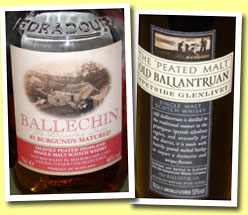 |
Ballechin
#1 (46%, OB, Burgundy matured,
6000 bottles, 2006)
 Edradour’s peaty novelty
has been finally bottled one good
month ago and came from Burgundy
hogsheads. Colour: salmony. Nose:
quite expressive at first nosing,
starting on smoke, red fruits
and the trademark farminess. Or
a burnt down cow stable that was
full of strawberries? Lots of
burnt cake, apricot pie, strawberry
cordial, whiffs of coal smoke,
flints, fresh walnuts.
Edradour’s peaty novelty
has been finally bottled one good
month ago and came from Burgundy
hogsheads. Colour: salmony. Nose:
quite expressive at first nosing,
starting on smoke, red fruits
and the trademark farminess. Or
a burnt down cow stable that was
full of strawberries? Lots of
burnt cake, apricot pie, strawberry
cordial, whiffs of coal smoke,
flints, fresh walnuts. |
|
Also a little rubber (new bicycle
inner tube) and quite some grilled
(hochicha) and smoked (lapsang souchong)
teas. Much more rounded than expected,
with it’s very own style (no
imitation Islay at all). Mouth:
the attack is more directly peaty
and vegetal (French beans, chlorophyll
chewing-gum) and maybe a tad drying
(quite some tannins – not
unlike cold over-infused tea) but
it gets then much better balanced,
the fruitiness coming through (strawberries,
blackcurrant jelly) together with
quite some caramel and cappuccino.
Something toasted. Certainly enjoyable,
with always this typical farminess
that’s better absorbed in
this peated version than in Edradour
I think. Finish: medium long, peaty,
malty and jammy, with also quite
some very ripe peaches. A good one,
very mature for its age (3 to 4
years I think) – certainly
a new voice nicely tamed by the
wine casks and probably the reduction.
This should be rather extravagant
at cask strength. 85 points. |
Old
Ballantruan (50%, OB, 2006)
 Another peated youngster from the
mainland, this time from Tomintoul
(the ‘Speyside Glenlivet’
name on the label may well be a
little misleading). Nose: little
peat but ultra-huge notes of caramel
at first nosing, very unusual. Lots
of vanilla as well, malted chocolate
(Ovomaltine), cornflakes…
Slowly switches to kind of a farminess,
with hints of manure, fermenting
vegetables and fruits, soaked peated
barley, wet chalk… Kind of
a liquorish sweetness in the background.
Very demonstrative and not exactly
subtle but rather pleasant I’d
say. Mouth: very sweet, less peaty
than the Ballechin, with again huge
notes of caramel, vanilla fudge
and roasted nuts. Is that natural?
Very malty as well, something Irish,
with also hints of violet and lavender
sweets, dates and smoked tea. Gets
slightly cloying after a while,
almost sugary. The finish is much
longer than the Ballechin’s,
invading, very vegetal now, cardboardy
and tarry, with also a schnaps-like
fruitiness. Not complex at all but
funnily wild and thick. A new generation
of malt for new generations of drinkers?
82 points.
Another peated youngster from the
mainland, this time from Tomintoul
(the ‘Speyside Glenlivet’
name on the label may well be a
little misleading). Nose: little
peat but ultra-huge notes of caramel
at first nosing, very unusual. Lots
of vanilla as well, malted chocolate
(Ovomaltine), cornflakes…
Slowly switches to kind of a farminess,
with hints of manure, fermenting
vegetables and fruits, soaked peated
barley, wet chalk… Kind of
a liquorish sweetness in the background.
Very demonstrative and not exactly
subtle but rather pleasant I’d
say. Mouth: very sweet, less peaty
than the Ballechin, with again huge
notes of caramel, vanilla fudge
and roasted nuts. Is that natural?
Very malty as well, something Irish,
with also hints of violet and lavender
sweets, dates and smoked tea. Gets
slightly cloying after a while,
almost sugary. The finish is much
longer than the Ballechin’s,
invading, very vegetal now, cardboardy
and tarry, with also a schnaps-like
fruitiness. Not complex at all but
funnily wild and thick. A new generation
of malt for new generations of drinkers?
82 points. |
|
|
|
October
22, 2006 |
|
 |
| TASTING
- THREE OLD GRAINS |
Carsebridge
1965/2006 (46%, Berry Bros, 425
bottles)  Colour: gold. Nose: starts on varnish
and old furniture right away, lots
of roasted nuts and American coffee.
Hints of smoke probably from the
wood, caramel crème, hot
croissants, freshly sawn oak…
Goes on with a little menthol, vanilla,
hints of bitter oranges… Rather
perfect if you like grain whisky.
Mouth: starts on quite some varnish
again but gets then very fruity
(lots of apple juice, very ripe
gooseberries, green bananas that
make me think of an Irish). Hints
of bubblegum, lots of vanilla again,
a little nutmeg… Nice oakiness,
with silky tannins. Not dry in any
way. And then again these nice mentholated
notes. Finish, medium long, very
fresh (vanilla ice cream), getting
just slightly bitter after a moment
(chlorophyll, green tea). Very nice
old grain whisky, in any case. 87
points.
Colour: gold. Nose: starts on varnish
and old furniture right away, lots
of roasted nuts and American coffee.
Hints of smoke probably from the
wood, caramel crème, hot
croissants, freshly sawn oak…
Goes on with a little menthol, vanilla,
hints of bitter oranges… Rather
perfect if you like grain whisky.
Mouth: starts on quite some varnish
again but gets then very fruity
(lots of apple juice, very ripe
gooseberries, green bananas that
make me think of an Irish). Hints
of bubblegum, lots of vanilla again,
a little nutmeg… Nice oakiness,
with silky tannins. Not dry in any
way. And then again these nice mentholated
notes. Finish, medium long, very
fresh (vanilla ice cream), getting
just slightly bitter after a moment
(chlorophyll, green tea). Very nice
old grain whisky, in any case. 87
points. |
Invergordon
1966/2006 (49.4%, Taste Still Selection,
bourbon cask #2722, 109 bottles)
 Colour: gold, slightly paler. Nose:
extremely close, maybe a tad rounder,
even more on caramel, coffee and
vanilla and less on fresh oak. Just
as nice – again, if you like
grain whisky. Mouth: this one differs
on the palate, it’s a little
rougher and less rounded. Maybe
more happening here, with lots of
soft spices (cinnamon, cloves, juniper)
but still quite some varnish. Nice
marzipan as well. Quite similar
other than that, with just a rather
longer and fruitier finish. Same
quality as the Carsebridge, maybe
just slightly more entertaining.
88 points.
Colour: gold, slightly paler. Nose:
extremely close, maybe a tad rounder,
even more on caramel, coffee and
vanilla and less on fresh oak. Just
as nice – again, if you like
grain whisky. Mouth: this one differs
on the palate, it’s a little
rougher and less rounded. Maybe
more happening here, with lots of
soft spices (cinnamon, cloves, juniper)
but still quite some varnish. Nice
marzipan as well. Quite similar
other than that, with just a rather
longer and fruitier finish. Same
quality as the Carsebridge, maybe
just slightly more entertaining.
88 points. |
Cameronbridge
27 yo 1979/2006 (56.6%, Duncan Taylor
for La Maison du Whisky, ‘From
Huntly to Paris’, cask #3526,
138 bottles)  Colour: pale gold. Nose: again,
we’re exactly in the same
vein. This one is maybe a tad closer
to the Carsebridge, slightly fresher
than the Invergordon, with again
quite some freshly sawn oak. Extremely
hard to come up with distillery
character on the nose – but
should there be any? Palate: punchier
of course, thanks to the higher
strength but the global profile
is similar again, maybe just a tad
simpler and more sugary. Lots of
vanilla and caramel as well as cappuccino.
Longer finish, very bubblegummy
now. A very good one again, no doubt
– although I must say tasting
three unsherried grains in a row,
even if very good ones, gets a bit
boring… 85 points.
Colour: pale gold. Nose: again,
we’re exactly in the same
vein. This one is maybe a tad closer
to the Carsebridge, slightly fresher
than the Invergordon, with again
quite some freshly sawn oak. Extremely
hard to come up with distillery
character on the nose – but
should there be any? Palate: punchier
of course, thanks to the higher
strength but the global profile
is similar again, maybe just a tad
simpler and more sugary. Lots of
vanilla and caramel as well as cappuccino.
Longer finish, very bubblegummy
now. A very good one again, no doubt
– although I must say tasting
three unsherried grains in a row,
even if very good ones, gets a bit
boring… 85 points.
|
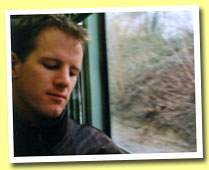 |
MUSIC
– Recommended
listening: it's Sunday so we go
classical with Sweden's (but he
lives in Paris) Erik
Wickström playing
Alban Berg's Piano
Sonata Op. 1.mp3. A rather stunning
piece Berg composed in 1908, that
sounds sometimes very Gershwinian.
Please go to Erik Wickström's
concerts. (via the piano
society) |
 |
NIOU
billet
en langue française ici
(avec un invité !) |
|
|
|
October
21, 2006 |
|
 |
|
TASTING - TWO OLD MORTLACHS
BY G&M |
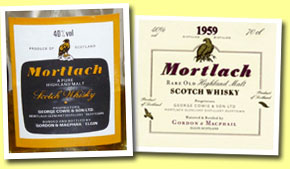 |
Mortlach
NAS (40%, Gordon & MacPhail,
1970’s)  Colour: apricot gold. Nose: starts
nicely flowery and fruity (nectar,
light honey, ripe apples) but also
frankly smoky and mineral. Whiffs
of coal, fireplace, flints…
Also a slight meatiness in the background,
something like ham. Not really bold
but rather playful and certainly
enjoyable.
Colour: apricot gold. Nose: starts
nicely flowery and fruity (nectar,
light honey, ripe apples) but also
frankly smoky and mineral. Whiffs
of coal, fireplace, flints…
Also a slight meatiness in the background,
something like ham. Not really bold
but rather playful and certainly
enjoyable. |
| Mouth:
granted, the attack is a little
low-key but not watery. Quite some
tea, honey, cake, cereals…
And again a slight smokiness together
with something pleasantly metallic.
Old bottle effect? Gets also a little
resinous and waxy… The middle
is a little weak, that is –
we really got used to higher strengths
– but the finish is ok, pleasantly
bitter and caramelly, with also
quite some tea (tannins). Rather
good. 80 points. |
Mortlach
1959/2001 (40%, Gordon & MacPhail)
 Colour: dark amber – mahogany.
Nose: oh, this one smells exactly
like a newly polished old cupboard.
Lots of cellulose varnish, beeswax
and ‘new’ leather at
first nosing… Fruits? Here
they are, with lots of blackcurrant
jelly, grenadine, cranberry juice…
And then we have these smoky, flinty
and slightly meaty notes like in
the ‘old new’ one. Goes
on with quite some roasted nuts,
black nougat… And finally
the expected resinous and minty
notes (just hints). Probably the
closest to old cognac whisky can
get. Sort of antiquated but really
excellent despite the low strength.
Mouth: extremely coherent with the
nose except that the varnishy notes
are slightly overwhelming at the
attack, the whole being also a little
drying. Really for cupboard makers,
this one ;-). What’s interesting
is that this kind of over-woodinesss
does not taste like a flaw here,
quite the contrary. The sherry is
present but discreet, it’s
really the wood that almost plays
solo. Now, we do have hints of roasted
raisins, coffee beans, bitter chocolate
and also cough drops… The
finish is surprisingly long, drying,
quite nicely tannic and slightly
sour… Closer to an old armagnac
than to a cognac on the palate,
in fact. Even something of an old
calvados (the dryness). Well, maybe
it’s like an antique car;
it’s less ‘perfect’
than a brand new one but it’s
got its own charms. A malt for nostalgic
people? For old MP’s? But
what a great nose! 88 points.
Colour: dark amber – mahogany.
Nose: oh, this one smells exactly
like a newly polished old cupboard.
Lots of cellulose varnish, beeswax
and ‘new’ leather at
first nosing… Fruits? Here
they are, with lots of blackcurrant
jelly, grenadine, cranberry juice…
And then we have these smoky, flinty
and slightly meaty notes like in
the ‘old new’ one. Goes
on with quite some roasted nuts,
black nougat… And finally
the expected resinous and minty
notes (just hints). Probably the
closest to old cognac whisky can
get. Sort of antiquated but really
excellent despite the low strength.
Mouth: extremely coherent with the
nose except that the varnishy notes
are slightly overwhelming at the
attack, the whole being also a little
drying. Really for cupboard makers,
this one ;-). What’s interesting
is that this kind of over-woodinesss
does not taste like a flaw here,
quite the contrary. The sherry is
present but discreet, it’s
really the wood that almost plays
solo. Now, we do have hints of roasted
raisins, coffee beans, bitter chocolate
and also cough drops… The
finish is surprisingly long, drying,
quite nicely tannic and slightly
sour… Closer to an old armagnac
than to a cognac on the palate,
in fact. Even something of an old
calvados (the dryness). Well, maybe
it’s like an antique car;
it’s less ‘perfect’
than a brand new one but it’s
got its own charms. A malt for nostalgic
people? For old MP’s? But
what a great nose! 88 points. |
MUSIC
– Recommended
listening: goldies but goldies
- We're in the mid-70's and Richard
Hell and his Voidoids
are doing their famous Blank
generation.mp3. One of the
first great american punk rock
LP's if memory serves... Please
buy Richard Hell's music, he's
still around and doing all sorts
of arty-crafty things (many in
France - often very good I must
say). |
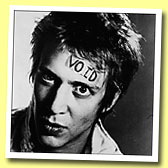 |
|
|
|
October
20, 2006 |
|
 |
| TASTING
- TWO OLD OFFICIAL HIGHLAND PARKS |
Highland
Park 28 yo 1977/2006 (48.5%, OB
for La Maison du Whisky, cask #4259,
217 bottles)  Colour: amber. Nose: rather expressive
at first nosing, with lots of fruit
jam, notes of fresh herbs but also
maybe a little too much rubber.
It’s soon to calm down, the
fruitiness having vanished and the
whole having got much less expressive,
except for quite some vegetal and
herbal notes.
Colour: amber. Nose: rather expressive
at first nosing, with lots of fruit
jam, notes of fresh herbs but also
maybe a little too much rubber.
It’s soon to calm down, the
fruitiness having vanished and the
whole having got much less expressive,
except for quite some vegetal and
herbal notes. |
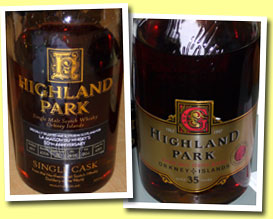 |
|
That’s a little bizarre I
must say but it already happened
the first time I tried this one.
Rather nice hints of lilies, though,
something milky… Other than
that we have the usual notes of
honey, beeswax and what everybody
calls ‘heather’, but
it’s all rather discreet.
Ah yes, also whiffs of wood smoke
and spearmint. A rather shy old
HP on the nose but it did improve
again after a moment. Mouth: a rather
bizarre attack, rather nervous but
with a slightly thin mouth feel.
Quite some marmalade, kumquats and
ripe apples but it sort of falls
apart after a while, with just a
few spices remaining (cinnamon,
a little nutmeg and maybe hints
of cloves) plus notes of dried pears
and pear spirit. Gets then quite
dry and drying, especially at the
slightly short and cardboardy –
and salty - finish, with just the
retro-olfaction being better and
a little bolder (quince jelly).
Sure it’s still very good
whisky but it’s a little disappointing
considering its pedigree…
86 points. |
Highland
Park 35 yo 1962/1997 (Cask Strength,
OB, John Goodwin retirement)
 Funny ‘G’ on the label
instead of the usual ‘H’,
in honour of ex-manager John Goodwin.
Colour: deep amber. Nose: this is
a completely different story! Starts
almost extravagantly, on old leather,
cigar humidor and lots of nutmeg.
Then it’s a maelstrom of aromas
– but an elegant and disciplined
kind of maelstrom (?): antiques
shop, old cupboard, old books, ginger,
heather honey, pollen, cedar wood,
Virginia tobacco… amazing.
Then we have something superbly
vegetal (a little chlorophyll, camphor,
eucalyptus leaves)… All that
keeps dry and straight, extremely
elegant, not unlike the best old
Springbanks – isn’t
that a pleonasm, by the way? Very
classy nose, that’s for sure.
Mouth: much bolder, much more invading
than the 1977. Superb spiciness
mingling with all sorts of dried
fruits, both exotic and ‘western’.
Ginger and cinnamon plus kumquats,
dried lychees and longans, soft
liquorice, argan oil, pistachios
and bitter almonds… Then figs,
prunes and huge notes of mirabelles…
Then verbena and chamomile…
The oak is very present but is really
an asset here, bringing a great
backbone to the whole. But beware
maltoporn, let’s go quickly
through the finish now (long, superbly
spicy, gingery, with notes of old
yellow chartreuse and always this
excellent mirabelle eau-de-vie).
Okay, 94 points
for this one (and thanks, Giuseppe).
Funny ‘G’ on the label
instead of the usual ‘H’,
in honour of ex-manager John Goodwin.
Colour: deep amber. Nose: this is
a completely different story! Starts
almost extravagantly, on old leather,
cigar humidor and lots of nutmeg.
Then it’s a maelstrom of aromas
– but an elegant and disciplined
kind of maelstrom (?): antiques
shop, old cupboard, old books, ginger,
heather honey, pollen, cedar wood,
Virginia tobacco… amazing.
Then we have something superbly
vegetal (a little chlorophyll, camphor,
eucalyptus leaves)… All that
keeps dry and straight, extremely
elegant, not unlike the best old
Springbanks – isn’t
that a pleonasm, by the way? Very
classy nose, that’s for sure.
Mouth: much bolder, much more invading
than the 1977. Superb spiciness
mingling with all sorts of dried
fruits, both exotic and ‘western’.
Ginger and cinnamon plus kumquats,
dried lychees and longans, soft
liquorice, argan oil, pistachios
and bitter almonds… Then figs,
prunes and huge notes of mirabelles…
Then verbena and chamomile…
The oak is very present but is really
an asset here, bringing a great
backbone to the whole. But beware
maltoporn, let’s go quickly
through the finish now (long, superbly
spicy, gingery, with notes of old
yellow chartreuse and always this
excellent mirabelle eau-de-vie).
Okay, 94 points
for this one (and thanks, Giuseppe). |
MOSSTOWIE
DISTILLERY PROFILE by Ho-cheng
Yao |
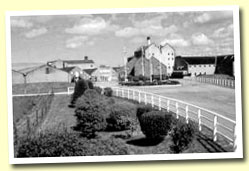 |
Operational:
1964~1981
Region:
Speyside (Lossie)
Neighbours:
Glenlossie, Glen Elgin
Address:
Miltonduff, Elgin, Morayshire,
IV30 3TQ
Last Owner:
Hiram Walker & Sons
Ltd.(later became part of
the Allied group) |
Mosstowie
was the single malt produced
by Lomond Stills in Miltonduff
from 1964 to 1981. It was
named after a hamlet about
a mile away from the distillery.
It’s the last distillery
to have installed Lomond stills.
There were two of them according
to many books, which may imply
the fact that these two Lomond
stills worked in tandem. But
as there's little information
about these lomond stills
I haven't been able to find
out more.
The Lomond still was invented
by Alistair Cunningham, who
was a chemical engineer at
Hiram Walker. The Canadian
company needed a solution
to have 42 differently flavored
malts within 6 distilleries
in hand. His solution was
a cylindrical still with a
water jacket mounted vertically
above it. Within the still
neck were three rectifying
plates that could be adjusted
horizontally and vertically,
and water-cooled or left dry
to vary the degree of reflux.
The angle of the lyne arm
could also be changed to allow
for even greater control of
the reflux. So, basically
the whole design was to control
the reflux to have different
styles of malts. Alas, the
process doesn't seem to have
been successfu as almost all
the Lomond stills installed
have been taken away, mostly
because the plates often became
clogged with residue.
I had the experience of tasting
4 different malts produced
from Lomond stills, they were
quite similar, creamy, fruity
and light.(I believe all were
coming from bourbon casks).
But remember, the Lomond still
was invented to produce very
different styles of malts,
so the extent of difference
must be the most important
factor. Michael Jackson, as
well as some other authors,
described Mosstowie as being
heavier, oilier and smokier
than the normal Miltonduff,
which I don’t quite
agree from my experience with,
for instance, the Mosstowie
Duncan Taylor bottling. In
fact, when Jim McEwan showed
me the Lomond Still he got
from Dumbarton site in 2004,
he also said this kind of
still will produce an extremely
light style of malt. But of
course he hasn’t got
the chance to try that yet.
I heard from him that they’ll
start to re-build Port Charlotte
distillery next year (2007)
and they’ll use the
Lomond still from Dumbarton
and an old pot still from
Port Charlotte in the Port
Charlotte distillery. Let’s
wait and see what will happen.
It is very hard to find Mosstowie's
malt in the market. Some available
IBs malts are:
Mosstowie 29 yo 1975 (44.5%,
Duncan Taylor Rarest of the
rare, Cask#5812)
Mosstowie 29 yo 1975/2005
(48,4%, Duncan Taylor, Rarest,,
c. 5809, 128bt)
Mosstowie 1979/1999 (40%,
G&M)
Mosstowie 12 yo 1972 (G&M)
Mosstowie 12 yo 1970 (40%,
G&M Connoisseur’s
Choice, old brown label)
Mosstowie 1975/1994 (40%,
G&M Connoisseur’s
Choice, old map label)
Mosstowie 1979/1999 (40%,
Connoisseur's Choice)
Mosstowie 1970 (40%, G&M
Connoisseur’s Choice,
Old map label)
Mosstowie 26 yo 1979/2006
(52.8%, Signatory, bourbon
cask #12756, 274 b.) |
I
just can’t help to open
my only Mosstowie in my collection.
I actually already tasted
this bottle during a DT tasting:
Mosstowie
29 yo 1975 (44.5%, Duncan
Tayler Rarest of the rare,
Cask #5812)
Color: Light gold. Watering,
not that oily. Large legs.
Nose: Very fruity. Lots of
citrus/orange, sweet. A little
bit of soapy flowery notes.
Hint of heather. Very clean.
A little bit pepperish, adding
water pulls more flowery notes.
Soap again.
Palate: Light body. Dry. Sweet.
Short finish. Even if it's
a little dry, it's quite active
as an old malt.
Conclusion: 85 points, still
a little too light for me.
- Ho-cheng |
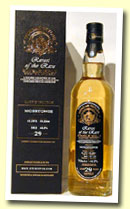 |
References:
Whiskey, Michael Jackson,
DK, First American Edition
2005
Whiskey, Walter Schobert,
Neil Wilson, English Edition
2002
The Scottish Whisky Distilleries,
Misako Udo, Distillery Cat,
November 2005 revised
Malt Whisky Yearbook 2006,
MagDig Media Limited 2005 |
|
MUSIC
- Recommended listening
- I know some will say this is
another very unlikely choice but
that won't prevent me from posting
about the late Harry
Nilsson doing Fred
Neil's interstellar mega-hit Everybody's
talking at me.mp3 in 1969.
Delightfully old-fashioned, but
please buy Harry Nilsson's music. |
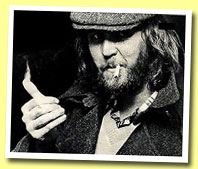 |
|
|
|
October
19, 2006 |
|
 |
| TASTING
– THREE INDIE 1981 BRORAS |
Brora
19 yo 1981/2000 (50%, Douglas Laing
OMC, 564 bottles)  Colour: dark straw. Nose: this one
is very demonstrative right at first
nosing, starting a Clynelishesque
waxiness plus lots of fruits (mostly
bitter oranges), getting then rather
farmy (wet hay, grain barn). Truly
superb.
Colour: dark straw. Nose: this one
is very demonstrative right at first
nosing, starting a Clynelishesque
waxiness plus lots of fruits (mostly
bitter oranges), getting then rather
farmy (wet hay, grain barn). Truly
superb. |
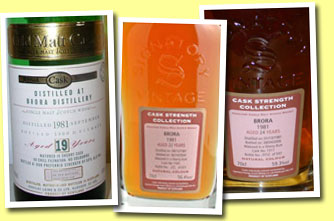 |
|
Then we have something resinous
coming through, with notes of pine
resin and tiger balm… And
then fresh apricots and almonds.
Again, superb. Mouth: punchy, with
a sweet and resinous attack. Something
citrusy (lemon balm?) and again
lots of wax, pollen, a slight cardboardinesss,
earl grey tea, spearmint…
A little icing sugar to keep the
whole very vivacious but no peat
or farminess at this stage. Long
finish, waxy and citrusy as it should
be, with hints of smokiness coming
through now and quite some lemon
juice. Very good – there wasn’t
only peat in Brora’s life!
88 points (and
thanks Konstantin). |
Brora
23 yo 1981/2005 (58.2%, Signatory,
sherry butt #1555, 535 bottles)
 Colour: pale amber. Nose: starts
much rougher and rawer but also
slightly peatier. Notes of wax again
but also a little cardboard, pond
water… Yet, it gets much more
expressive after that, with quite
some ginger ale, hints of wet dog,
sweat straw, beer… Sharper
and more austere than the OMC but
it gets really peaty and smoky after
a moment. Not close to a Brora from
the early 70’s of course but
it is a classy one. Mouth: much,
much closer to the OMC, just even
punchier at the attack. Resin, wax,
orange zests, icing sugar…
We’re very, very close, with
maybe just something slightly meaty
now (ham). Very good. Finish: slightly
hotter but other than that it’s
the same whisky. 88 points
– up 1 point since last time
I had it (and thanks, Carsten
H.)
Colour: pale amber. Nose: starts
much rougher and rawer but also
slightly peatier. Notes of wax again
but also a little cardboard, pond
water… Yet, it gets much more
expressive after that, with quite
some ginger ale, hints of wet dog,
sweat straw, beer… Sharper
and more austere than the OMC but
it gets really peaty and smoky after
a moment. Not close to a Brora from
the early 70’s of course but
it is a classy one. Mouth: much,
much closer to the OMC, just even
punchier at the attack. Resin, wax,
orange zests, icing sugar…
We’re very, very close, with
maybe just something slightly meaty
now (ham). Very good. Finish: slightly
hotter but other than that it’s
the same whisky. 88 points
– up 1 point since last time
I had it (and thanks, Carsten
H.) |
Brora
24 yo 1981/2006 (59.3%, Signatory,
sherry butt #1517, 597 bottles)
 Colour: pale amber. Nose: much closer
to the OMC than to it’s sibling
by Signatory, with exactly the same
kind of mix of wax and fruits plus
the trademark farminess at first
nosing. Now, it develops in a different
direction, more on coffee and caramel
(Werther’s) plus roasted nuts.
Hard to tell you which nose I prefer.
Mouth: same whisky again on the
palate, with just a little extra-power
from the alcohol and maybe a feeling
of saltiness (from the alcohol???)
Finish: a bit creamier and longer
but again, it’s just the same
whisky. 88 points.
Colour: pale amber. Nose: much closer
to the OMC than to it’s sibling
by Signatory, with exactly the same
kind of mix of wax and fruits plus
the trademark farminess at first
nosing. Now, it develops in a different
direction, more on coffee and caramel
(Werther’s) plus roasted nuts.
Hard to tell you which nose I prefer.
Mouth: same whisky again on the
palate, with just a little extra-power
from the alcohol and maybe a feeling
of saltiness (from the alcohol???)
Finish: a bit creamier and longer
but again, it’s just the same
whisky. 88 points. |
MUSIC
– Recommended
listening: Brazil's excellent
vocalist Zeze
Freitas sings
Zica Bergami's Manga.mp3,
with the excellent Rodrigo Botter
Maio on saxophone. Superb! Please,
buy these people's music. |
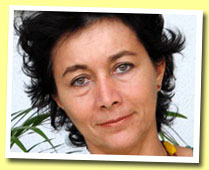 |
|
|
|
October
18, 2006 |
|
 |
| TASTING
- TWO BUNNAHABHAINS |
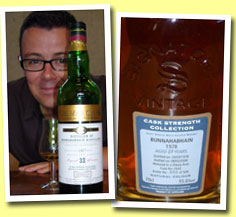 |
Bunnahabhain
33 yo 1967/2001 (41.25%, Douglas
Laing Old Malt, US, 204 bottles)
 Colour: pale gold. Nose: a rather
expressive start on oak and fruits
(bananas, guavas, overripe apples,
tangerines), in a style that isn’t
too far from old Bowmores or Bruichladdichs.
Superb freshness considering its
age, the whole gaining balance with
time. It gets less extravagantly
fruity (but now e have also ripe
gooseberries and pears) but slightly
camphory as well as very nicely
and softly spicy (a little ginger,
cloves, cinnamon, nutmeg).
Colour: pale gold. Nose: a rather
expressive start on oak and fruits
(bananas, guavas, overripe apples,
tangerines), in a style that isn’t
too far from old Bowmores or Bruichladdichs.
Superb freshness considering its
age, the whole gaining balance with
time. It gets less extravagantly
fruity (but now e have also ripe
gooseberries and pears) but slightly
camphory as well as very nicely
and softly spicy (a little ginger,
cloves, cinnamon, nutmeg). |
|
And then it gets nicely soft (like
a morning sunrise, err…),
slightly oriental, on whiffs of
incense, sandalwood and smoking
nargileh, with a final, rather bold
return on ripe bananas. Typical
and flawless. Mouth: exactly as
expected, with a very nice attack
on bananas flambéed and coconut
milk plus quite some vanilla and
a rather bold oakiness (slightly
overinfused tea). Add to that a
little liquorice, orange cake, Grand-Marnier,
apricot jam and you have a very
expressive old Bunny, with a rather
long, fruity finish with no excessive
dryness whatsoever despite the oak
that’s well here. Not hugely
complex on the palate but the balance
is totally perfect. 91 points
(and thanks, Luc) |
Bunnahabhain
27 yo 1978/2006 (55.6%, Signatory,
cask #2542, 509 bottles)
 Colour: full gold. Nose: punchier,
more spirity, starting on very unusual
notes of ambergris and quite some
vanilla. Also something slightly
metallic (copper saucepan), lilies
of the valley, mastic, argan oil,
suntan lotion, paper, plastic (new
car)… Again, very unusual.
Then we have wet stones and chalk,
seltzer… And then the sherry
comes through, after a good five
minutes, the whole getting much
more classical: sultanas, rancio,
soy sauce, parsley, a little fresh
mint, caramel crème…
Very entertaining if you give this
one a little time! Mouth: punchy
but not violent, with a very thick
mouth feel (you could use a spoon
I guess). Starts mostly on all kinds
of both crystallized and dried fruits
(no need to list them all) plus
a little caramel. Very lively and
‘candied’, with just
something slightly rubbery in the
background (more like chlorophyll
actually). It stays like that for
a very long time, resembling a fruit
liqueur more and more, until the
finish that’s hugely…
err, fruity and candied. Very simple
on the palate but so nicely compact
and coherent that simplicity’s
almost an asset here. 89
points.
Colour: full gold. Nose: punchier,
more spirity, starting on very unusual
notes of ambergris and quite some
vanilla. Also something slightly
metallic (copper saucepan), lilies
of the valley, mastic, argan oil,
suntan lotion, paper, plastic (new
car)… Again, very unusual.
Then we have wet stones and chalk,
seltzer… And then the sherry
comes through, after a good five
minutes, the whole getting much
more classical: sultanas, rancio,
soy sauce, parsley, a little fresh
mint, caramel crème…
Very entertaining if you give this
one a little time! Mouth: punchy
but not violent, with a very thick
mouth feel (you could use a spoon
I guess). Starts mostly on all kinds
of both crystallized and dried fruits
(no need to list them all) plus
a little caramel. Very lively and
‘candied’, with just
something slightly rubbery in the
background (more like chlorophyll
actually). It stays like that for
a very long time, resembling a fruit
liqueur more and more, until the
finish that’s hugely…
err, fruity and candied. Very simple
on the palate but so nicely compact
and coherent that simplicity’s
almost an asset here. 89
points. |
LOCH
EWE DISTILLERY PROFILE
AND
INTERVIEW WITH JOHN CLOTWORTHY
by
Nico Meijboom (MM correspondent) |
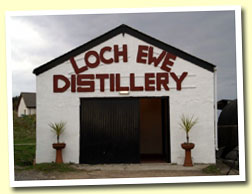 |
Operational:
License to operate
granted on 20 June 2006
Region:
Northern Highlands (West
coast)
Address:
Drumchork Lodge Hotel, Aultbea,
Wester Ross, IV22 2HU, Scotland
Owners:
John and Frances Clotworthy
Contacts:
website
- email
Tel: +44
1445 731242 |
| After
3 whisky trails in Scotland
with friends from “Het
Genietschap” and a family
trip to the Speyside, I convinced
my spouse Rianne that it would
be a great idea to return
to Scotland in 2006 with just
the two of us. Because she
is not to keen on whisky we
made an agreement upfront
and split the week in Scotland
from April 27 to May 7 equally
between whisky related events
and beautiful scenery. After
visiting some distilleries
and thoroughly enjoying the
Speyside whisky festival 2006
we travelled on 1 May from
Dufftown to Wester Ross. |
| In
Tain I promised Rianne that
the Glenmorangie stills would
be the last copper still she
would see this year. After
a short stop at Brora later
that same day, we drove into
the wastelands of Wester Ross.
In order to ensure at least
some proper dramming in Wester
Ross I had cunningly booked
one night at the Drumchork
Lodge Bed & Breakfast
in Aultbea. The Drumchork
Lodge is run by Frances Oates
and John Clotworthy, who have
gained international renown
for the hotel as “The
Highland Home of Malt Whisky”,
winning numerous awards for
both the collections and presentations
of Scotland’s National
drink and have also won Top
Whisky Bar in Scotland several
times with its 700 single
malts on the shelf. |
|
|
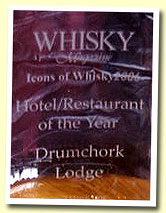 |
| After
a few days of enjoying the
stunningly beautiful and lonely
landscape of Wester Ross we
finally arrived at Aultbea
and I was pleasantly surprised
to discover a brand new distillery
named “Loch Ewe”
right next to the hotel. |
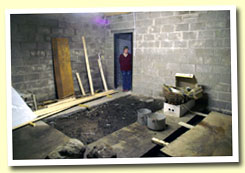
Works in the garage |
This
new distillery is the brainchild
of John and Frances, who transformed
a garage behind the hotel
into a distillery and were
recently granted a distillery
licence - the first private
licence in 190 years. This
makes Loch Ewe now officially
the smallest legal distillery
in Scotland; a title previously
held by Edradour. However,
the extremely small alembic
still of Loch Ewe is from
a different order of magnitude
than Edradour’s stills
and there is no intention
at all for Loch Ewe to become
a competitor to the existing
distilleries. |
| John’s
intention is that guest to
the hotel can learn in a 5
day course how whisky was
prepared in the old days.
The guests will brew, ferment
and distil using an illicit
size still and cask it at
the end of the week. This
new Single Malt drink will
be called “The Spirit
of Loch Ewe” and not
single malt whisky. For practical
reasons it is not possible
for the spirit to mature for
3 years, because of the extremely
high evaporation rate from
the currently used small casks
(only 5 litres!!). In the
future John expects to fill
a couple of ex-bourbon casks
as well in order to create
also an official Loch Ewe
Scotch single malt whisky.
Rianne did not mind at all
to learn more about this charming
small copper still and of
course we got the full tour
from John. By coincidence
the guys from “the Malt
Project” where at Loch
Ewe on the same day to shoot
some footage for their next
release. |
|
It will take a couple of years
before the first tasting notes
of Loch Ewe single malt scotch
will appear on this website,
but there is an opportunity
to sample “The Spirit
of Loch Ewe” at the
Leiden whisky festival 2006,
where John will be present
to promote his distillation
course. For the time being
the connoisseur has to do
it with the pictures of this
charming distillery. |
Interview
with John Clotworthy (17
September 2006) |
| John,
thanks for making yourself
available for this interview
for the Malt Maniacs website.
Can you start by giving a
short introduction to yourself
and how you developed your
affection for malt whisky
to the extend that you wanted
to start your own distillery?
|
I
am enjoying whisky for more
than 20 years now. The first
bottle of single malt whisky
I bought was Highland park
12Y. When I took over the
Drumchork Lodge hotel in 1997
there was nothing on the shelves
and here I also started with
Highland Park 12Y. Now my
collection has grown in 9
years time to over 700 different
whiskies. The majority of
them are single malts, but
I have an open mind for all
whiskies as I believe they
can all be enjoyable on a
particular point in time.
The idea to start my own
distillery was inspired by
comments and questions I got
when I was hosting Nosing
and Tastings. People asked
if they could learn in practice
how whisky was prepared in
the old days of illicit distilling. |
| Was
it difficult to obtain a license
for distilling? |
| Yes,
the Customs and Excise department
initially would not allow
a license because under the
current legislation the minimum
volume of a still must be
1800 litres and mine is just
40 gallons. However, my still
has the same size as the one
from John Smith of Glenlivet,
when he got his licence in
1824. After 2 years of campaigning
with help from Members of
Parliament, a license was
granted in 2004. Then it took
us another 2 years to build
the distillery in a garage
next to the hotel and to complete
the additional work required
for the license. We recently
received the final document
dated June 20 2006. It is
a weird coincidence to see
the date 2006-2006 on the
license; I take it as a positive
omen for my distillery. This
is by the way the first private
license rewarded in 190 years. |
| Do
you have any previous distilling
experience? |
| No,
I have been talking and learning
from several people with experience.
Nowadays distilleries are
completely run by computers.
This type of distillation
goes back to the fully manual
process. |
| What
is the capacity of the still
per batch? |
| As
it is all done in one pot
we start with 25 gallons of
water and 25 kg of malted
barley. At the end of the
second distillation we obtain
roughly only 5 litre of 75%
spirit. |
| Do
you use a particular type
of barley and who takes care
of the malting? |
| I
purchase milled malted barley
from the Inverness maltings
and have no preference for
barley type as yet. One of
my plans for the future is
to try to make my own malted
barley. |
| Any
preference for peat level?
|
| My
first trial runs were with
unpeated barley. Because we
are in a coastal area I would
like to move to light peated
barley. Not as peaty as Ardbeg,
but more peaty than Bunnahabhain. |
| Do
you use a particular yeast
strain? |
| Standard
dried yeast, but I am currently
looking for a faster fermentation
yeast. |
| Water
source for malting and cooling?
|
| First
trial runs were done with
the high quality tap water
we have in this area. When
we start with the distilling
classes we can use water from
a nearby loch. |
| Can
you tell something about the
process using an alembic still? |
Mashtun,
washback, wash still and
spirit still are all in
one pot. We are using an
alembic pot still which
was used by the ancient
Egyptians to produce perfumes
and aromas as far back as
200BC. Around 200AD European
monks were using this design
of still to make pot ales
and their fortified wines.
That's where the Aqua Vitae,
the water of life, comes
from.
We
dismantle the still and
use just the copper pot
to start with a porridge
of malted barley and hot
water. The filtering of
the wort from the draff
is done with great difficulty.
The wort is put back into
the copper pot and yeast
is added. After fermentation
the wash is heated and the
still part is added. The
low wines are collected
and after cleaning the pot
the second distillation
should yield approximately
5 litres of spirit at 75%. |
| What
barrels do you use? |
| It
took a while to find a supplier
for the type of casks I had
in mind (5-10 litres). I managed
to find a supplier in Germany,
so the wood type can be called
German Oak. The casks have
been charred and I can put
sherry in them to precondition
the wood, depending on the
customer’s preference.
The cask can contain a volume
of 5 litres of spirit. |
| Maturation
time? |
| Here
is a practical problem. Legally
you are only allowed to call
the distillate Scotch Whisky
after 3 years of maturing
in Scotland. However, after
3 years a 5 litre cask will
be empty.We will therefore
not call it whisky, but the
official name is “Spirit
of Loch Ewe”. I expect
that a couple of months maturing
should be sufficient. |
| How
did your first runs go? |
| Very
well. Once I got used to operating
the equipment I was quite
impressed with the results.
The taste of the unpeated
spirit is very fruity and
cereal. |
| What
is the plan forward? How to
attract visitors to the lodge/distillery?
Planning any classes? |
| As
a matter of fact I have just
been updating the website
of our hotel. The course lasts
5 days and will include dinner,
bed and breakfast and duty
paid on the spirit. I have
been promoting on Whisky Live
in Glasgow and will be at
the whisky festival in Leiden
in November. |
| What
is the price of the course? |
| This
depends on the size of the
group and what they want.
For details people can contact
us for an individual package
price. |
| Is
it possible to let the spirit
mature in your own warehouse? |
| Yes,
but I really recommend that
people take the cask home.
Because of the high evaporation
rate from such a small cask
it will be empty after 3 years
in our warehouse. After a
couple of months it should
be fine for consumption. |
| Been
in touch with Edradour recently
on your newly acquired status?
|
| I
have not talked to Andrew
Symington recently. It is
not my intention at all to
start to promote ourselves
as the smallest distillery
in Scotland, although I have
the legal right to do so.
I would more advocate Loch
Ewe to be the “most
unique distillery”.
|
| John,
thanks for your time for this
interview and we are looking
forward to see you at the
Leiden festival in November
and sample some “Spirit
of Loch Ewe”. |
| You’re
welcome. See you in November. |
|
MUSIC
- Heavily recommended
listening - not exactly amusing
but totally beautiful: Blake
Allen singing a soulful
Executioner's
song.mp3 that will leave you
speechless. Wow! Please, please
buy Blake Allen's music... |
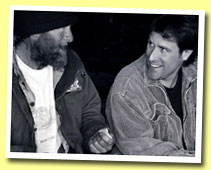 |
|
|
|
October
17, 2006 |
|
 |
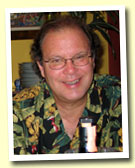 |
|
|
E-PISTLE
WHISKY
LIVE TORONTO 2006
by Davin de Kergommeaux
(Canada)
You’d
expect any event held in
Paris to be world class,
Paris being a centre of
fashion, culture, and the
cultivated. Whisky
Live Paris met that
expectation and more. With
everything San Francisco
has to offer a whisky show
there would have to be pretty
amazing and the Whiskies
of the World Expo was.
|
| In
Canada however, not much happens
in the malt world so you could
be forgiven for not expecting
much of a show. But then along
comes the Victoria
Whisky Festival in sleepy
little Victoria – population
350,000 and a two hour ferry
ride from anywhere - to prove
what can be done by folks
with a mission; the Victoria
show too, was fantastic. |
| In
Toronto sale of whisky is
regulated by LCBO,
a government monopoly with
virtuoso talents for sucking
the life out of the whisky
hobby, and now they have applied
that virtuosity to whisky
shows as well. For two years
running, our friend Johanna
Ngoh has brought all the major
players together each Fall,
in Toronto, for her acclaimed
Spirit
of Toronto whisky show.
LCBO blocked her every move,
but the wily Johanna found
other means to bring in great
whiskies and great Scottish
characters to go with them. |
| Then
LCBO asked the Whisky Live
folks if they’d ever
thought of bringing their
consumer show to Toronto.
“A fair question of
interest given the business
we’re in,” they
told me. Only thing is, Whisky
Live’s dates magically
coincided with LCBO’s
annual pre-Christmas whisky
promotion in October. But
with Spirit of Toronto already
scheduled for October, LCBO
in a stroke of passive-aggressive
brilliance, managed to push
the upstart Johanna off the
calendar and deliver half
the show at twice the price.
Yes, twice the price, because
at Whisky
Live Toronto
you must purchase your drams
– no free sampling –
and while the stated purpose
of selling vouchers is to
control drunkenness the effect
was just the opposite. |
| With
drams ranging from $2.50 to
$7.50 (for mostly very ordinary
whiskies) the whisky show
quickly became a whisky bar
with people demanding full
measures and downing every
drop. Remember the silver
dump buckets and spittoons
at Whisky Live Paris, Victoria
Whisky Festival and World
of Whiskies Expo? They were
nowhere in sight here, although
a few plastic garbage pails
did substitute service. |
| Organizer,
Damien Riley-Smith put on
a brave face, saying he had
a wonderful venue to grow
into over the coming years.
Well, he’s right. It
was a large venue, made to
seem all the larger for the
lack of people. Damien estimated
the crowd at 850; I’d
guess half that number. Take
your lumps Damien. You’ve
been LCBOed. It won’t
ever get better than this
if you continue to work with
them, and how can a big organization
like yours not? |
| Consider
that for their “Whisky
Generation” promotion
LCBO is bragging about the
“sensational selection”
of new malts they are making
available in Toronto. Such
“sensations” as
Green Spot, Highland Park
18yo, Old Pulteney 12yo, The
Macallan 15 yo Fine Oak, Aberlour
16yo, Te Bheag (and LCBO still
thinks Praban Na Linne is
a distillery – LISTEN
LCBO: THERE IS ONLY ONE DISTLLERY
ON SKYE AND IT’S CALLED
TALISKER. Praban Na Linne
IS NOT A DISTILLERY, IT’S
A BUSINESS OFFICE and Te Bheag
is a blend. That means it
is a mixture of whiskies that
come from many different distilleries
- but I digress.), Edradour
10yo, Glengoyne 17yo, Glen
Garioch 15yo, Auchentoshan
Three Wood, Bowmore 16yo 1989,
Bowmore 17yo, Ardbeg Ugeadail,
Arran 10yo, and, . . . oh
wait, . . . that’s the
whole list and not a sensational
one among them. Remember Damien,
this for a city of 2.5 million
people. |
| Producers
and brand ambassadors also
stayed away from Whisky Live
in droves. Where were the
Bruichladdich folks for instance?
Their drams made my day at
WL Paris and Victoria Whisky
Fest. And are they leading
a general retreat? One prominent
exhibitor was wondering aloud
last night if these whisky
shows are getting to be too
much work for too little return.
To be fair though, there were
some outstanding malts there
as well. Two Tullibardines,
a 1966 and a 1964 were the
best I’ve ever tasted
from that distillery, and
Diageo had a terrific line-up
of Taliskers as well as pouring
three UDRM Rare Malts in their
Masterclass. Michael Jackson
cancelled at the last minute
(health) but Ronnie Cox was
his normal, brilliant self,
though the only real star
to attend. |
| “
But did you have fun?”
Damien asked when I expressed
my disappointment, and yes,
that was a fair question because
I did have fun, not from the
whiskies, but because the
show gave us Canadians a gathering
point to see those folks we’ve
only met on the web. Rob Faragher,
for instance, brought a group
from St. Catherines and after
the show we retired to his
hotel where another whisky
festival began, with half
a dozen drams I’d never
seen before. Damien, you’re
doing us whisky nuts a real
service with your shows and
your magazine. Thank you for
all the other Whisky Lives.
I hope you didn’t lose
too much on Toronto and if
you do come back next year,
come on over to Rob’s
room after. We’ll give
you some real drams the folks
at LCBO have never even heard
of. |
| Johanna
has not replied to our requests
for information but her website
says she’ll do her show
in the Spring. Fingers crossed
that she repeats her past
successes. - Davin |
November
6, 2006
Whisky
Live Toronto – Correction
Damian Riley-Smith (note correct
spelling of his name - sorry
Damian) advises that final
attendance at Whisky Live
in Toronto was 788, and not
half of 850 as reported. By
comparison Whisky Live South
Africa had over 10,000 visitors
over six nights last year.
Johanna Ngoh responding to
our review of Whisky Live
advised that she is still
working at her whisky business,
though she gave no details.
- Davin |
|
TASTING
– TWO 1978 PORT ELLENS
Port
Ellen 23 yo 1978/2002 (59%, Signatory,
butt #5268, 564 bottles)
 Colour: pale straw. Nose: powerful
and pungent at first nosing, not
very smoky and rather farmy (huge
notes of wet hay, fermentation).
Gets then rather minty and vegetal
but the whole is rough and not
very expressive. It’ll probably
need a little water…
Colour: pale straw. Nose: powerful
and pungent at first nosing, not
very smoky and rather farmy (huge
notes of wet hay, fermentation).
Gets then rather minty and vegetal
but the whole is rough and not
very expressive. It’ll probably
need a little water… |
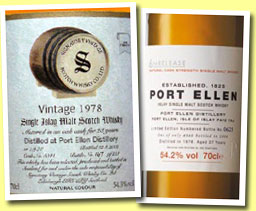 |
| Okay,
great news, that does work. I gets
much more ‘coastal’,
with notes of seashells, iodine,
developing on diesel oil, tar, maybe
hints of ‘new plastic’…
Not a winning nose but certainly
a nice one. Mouth (neat): ultra
sweet at first sip, but with quite
some cardboard and even a slight
soapiness. Too much alcohol, this
one really needs water. So, with
water again: it got much sweeter,
on apple compote but also tea, white
pepper, ginger. Gets earthier and
earthier, rooty, with also notes
of ginger tonic, cinchona and bitter
oranges, probably from the wood.
Rather long finish, peppery, mustardy
and smoky, maybe more like some
Taliskers rather than ‘regular’
Port Ellens at the finish. Not stellar
and slightly atypical but very good,
that’s for sure. 88
points. |
Port
Ellen 27 yo 1978/2006 (54.2%, OB,
6th Release, 4560 bottles)  Colour: straw. Nose: much ‘easier’
than the Signatory at first nosing,
starting on lots of lemon juice
and smoked tea (lapsang souchong).
It’s soon to get unusually
maritime (some would say ‘fishy’)
with notes of smoked oysters but
also kippers – clean ones.
Lots of iodine. Then we have freshly
cut apples, peaches, green melons…
Whiffs of newly cut grass, chives…
It’s probably a little more
civilized and tamed than most earlier
versions I think, but maybe also
a little more complex. No tarry
notes, no new tyres this time but
it’s very expressive just
like that but let’s see what
it gives with a little water: not
much development but it already
told us lots of things. Not exactly
a swimmer in fact – at least
on the nose. Mouth (neat): peaty,
waxy, salty and lemony, with an
almost perfect balance right at
first sip. Again, it’s a little
rounder than ‘usual’,
maybe a little more ‘obviously
good’ and less austere and
sharp than most previous editions.
Gets quite spicy (green curry, soft
wasabi) and liquoricy before we
have quite some fruits such as bitter
oranges and tangerines. With water:
gets a little fruitier and even
spicier, in a beautiful way. Notes
of quince jelly, herbs liqueur,
parsley and dill, getting more and
more peppery, especially at the
very long, beautifully sharp and
invading finish – maybe the
best part here. Very compact, with
a superb earthiness remaining on
your palate for ages (plus my beloved
old Pu-erh tea). That superb finish
will lift its mark from 90 to 92
points.
Colour: straw. Nose: much ‘easier’
than the Signatory at first nosing,
starting on lots of lemon juice
and smoked tea (lapsang souchong).
It’s soon to get unusually
maritime (some would say ‘fishy’)
with notes of smoked oysters but
also kippers – clean ones.
Lots of iodine. Then we have freshly
cut apples, peaches, green melons…
Whiffs of newly cut grass, chives…
It’s probably a little more
civilized and tamed than most earlier
versions I think, but maybe also
a little more complex. No tarry
notes, no new tyres this time but
it’s very expressive just
like that but let’s see what
it gives with a little water: not
much development but it already
told us lots of things. Not exactly
a swimmer in fact – at least
on the nose. Mouth (neat): peaty,
waxy, salty and lemony, with an
almost perfect balance right at
first sip. Again, it’s a little
rounder than ‘usual’,
maybe a little more ‘obviously
good’ and less austere and
sharp than most previous editions.
Gets quite spicy (green curry, soft
wasabi) and liquoricy before we
have quite some fruits such as bitter
oranges and tangerines. With water:
gets a little fruitier and even
spicier, in a beautiful way. Notes
of quince jelly, herbs liqueur,
parsley and dill, getting more and
more peppery, especially at the
very long, beautifully sharp and
invading finish – maybe the
best part here. Very compact, with
a superb earthiness remaining on
your palate for ages (plus my beloved
old Pu-erh tea). That superb finish
will lift its mark from 90 to 92
points. |
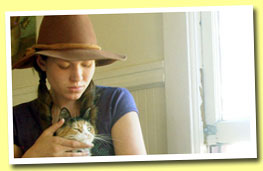 |
MUSIC
– Recommended
listening: today we'll have some
of Alela
Diane's 'pirate's
gospel' with The
rifle.mp3. Great new voice
I think, please buy her music! |
|
|
|
October
16, 2006 |
|
 |
CONCERT
REVIEW by Nick Morgan
THE BLACK KEYS
The Forum, Kentish Town, London,
October 4th 2006 |
 |
Well
they may still be picking cotton
in Mississippi, but back here in
London autumn has set in, chilly
mornings, early evening gloom and
cold nights. This time of year also
brings a new crop of fresh-faced
students to the great metropolis,
and it feels as though most of them
are here in the Forum with us. Neatly-pressed
grunge meets GAP outfits, too much
money, too much beer, and rather
too much pop-eyed wonderment at
the simple glory of being grown
up like this. |
| Of
course most of them are boys. And
to a man (or boy) they are all closet,
or wardrobe, or garage, or may I
say even basement guitarists –
even the daft ones trying to do
a mosh pit thing at the front. Yes,
this cool autumnal night is about
newly-found maturity celebrated
with the king of bedroom blues guitar. |
| It’s
the
Black Keys. You know,
the two-hand outfit that shot to
fame shortly after that other two-hand
outfit, the White Stripes. Actually
I didn’t really know that
the Black Keys had shot to fame,
so was astonished to find the Forum
sold-out and almost bursting at
the seams. I thought the scene was
dominated by Jack and Jill, the
roots blues supremos of the chic
and chi-chi city set, who of course
probably only know roots if they’re
in their hair and need colouring.
So whilst the White Stripes have
almost become Big Apple social accessories,
like one of those irritating little
dogs that always simpers and shits
on the sidewalk, the Black Keys
have clung tenaciously and obstinately
to their ‘roots’ origins
of Akron, Ohio. They are, as critics
might say, stuck in the basement.
And even worse, to those star-spangled
North east metro-sophisticates whose
knowledge of their own country finishes
at the end of the JFK runway, the
Black Keys are stoically signed
to those wonderful people at Fat
Possum Records in Oxford, Mississippi,
where if I’m not mistaken,
they might still be picking cotton. |
| Dan
Auerbach presides over the evening
with the bearing of a man who’s,
well, to be honest, playing the
guitar in his bedroom. He seems
almost oblivious to the audience,
and barely seems to communicate
with sidekick Patrick Carney, though
the two are as tight as ninepence.
Technicians might like to know that
his two Marshall amps, rather than
facing the audience are very deliberately
pointed to the side, heavily miked.
There are pedals all over the place,
at least one of which stalls half
way through the evening. I think
he’s playing the Gibson with
the Bigsby – but hey, if you
want to check up on the details
of this stuff then just look at
the ‘Guitar Geek World’
section on the band’s forum.
I have a feeling most of the audience
do.It was Auerbach, by the way,
whose life was changed listening
to a Junior Kimbrough album in,
surprisingly, his room at college.
And though the majority of their
tunes are self-penned it’s
an inspiration that the band are
happy to acknowledge – indeed
what better place to start if you
don’t know them than their
recent tribute to Kimbrough, Chulahoma.
Of course it’s easy to stress
the derivative nature of their work,
as intense blues groove follows
intense blues groove. You half expect
that the next line in every song
will be “Well I’m standing
next to a mountain”, and in
addition to Hendrix you’ll
hear as many seventies bands in
their tunes as you can remember.
|
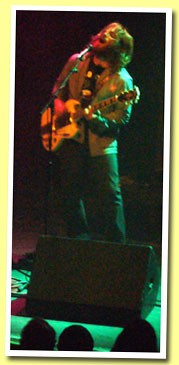
Dan Auerbach |
| But
this would do the Black Keys a great
injustice – their music is
nothing but twenty-first century
blues. Auerbach is a prodigious
guitarist (did I also say that he
also has the voice of a blues angel?),
and it’s clear that in a set
that lasts an hour (to the minute)
there’s nothing wasted, nothing
thrown away. Apart from the pedal
breaking it’s almost technically
perfect – I know that from
the detailed notes the bloke next
to me was taking. The audience of
course are almost at prayer –
they’re as familiar with the
old stuff (I would suggest that
after Chulahoma you buy 2003’s
thickfreakness, and then this year’s
Magic Potion) as the new, and no
Serge, I don’t mean they’re
singing along, they’re playing
along in their heads. |
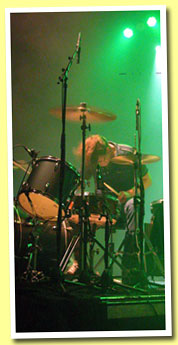
Patrick Carney |
Hang
on, what about the drummer? That’s
Patrick Carney, who is also a bit
of a dab hand at producing albums
too. Well according to the pimple-pinching
pre-pubescents who occupy the Black
Keys forum he’s a bit of a
miserable bugger, because all he
does is come on stage and play the
drums. What do they expect –
tap-dancing and jokes? Let me tell
you, no matter how good Auerbach’s
guitar and singing was, this show
was simply blown away by the power
drumming of Mr Carney. In fact it
wasn’t like being at a gig;
it was more like a boxing match.
And the bastard won every round.
It went like this. Bell rings –
soft approach, squirrelling round
the snares, some light cymbals,
a slow but incessant foot pedal
on the bass drum. Audience seduced
into blues rhythm and great singing,
caught unawares.First the bass drum
intensity increases. Then, “Christ,
how can he do that with one foot?”
The snare starts to kick in and
the cymbals are going off everywhere,
along with the tom-toms. By this
time the bass pedal is slugging
in the chest every time, pounding
away. Can I take it? Deep breath
– yes – it’s hot,
but it’s cool. How naive.
Without warning the bass pedal triples
in ferocity and the floor mounted
tom-toms start punching and pounding
at you like a veteran heavyweight
moving in for the kill. On the ropes!
It’s the quorum in the Forum.
Too much. |
| Down
and almost counted-out. Drummer
Patrick rises, spits out water contemptuously
as a scantily-clad babe circles
the stage with a board pronouncing
“Song Two”. An invisible
coach massages his neck, “You’ve
got them champ, you’ve got
them.” At the end of the hour
he leaves the stage without a look,
impatient, knowing that his job’s
not quite done. Encore – the
final round – the Kentish
Town Killer beats us to submission.
Only then, only then, does he turn,
grin, and give us one wave. Phew! |
And
Serge you know it’s easy to
make jokes at other people’s
expense (thank heavens!) but one
of the best things about this wonderful
evening was that we’re here
in this packed old theatre, listening
to nothing but the blues, and the
audience, average age 23, is loving
it. And for that I say thank you
Black Keys, (and of course thank
you North Mississippi Allstars,
and thank you Fat Possum Records,
and even thank you White Stripes).
Buy their records, go and see them.
Keep the blues alive!
-
Nick Morgan (photographs by
Kate and Cadd). |
Thank
you, Nick. Jimi Hendrix had so
many grandsons! I’ll spare
you laborious and unnecessary
developments on ‘but is
this creation’ or ‘no
bass, subconsciously deliberate
mistake or marketing gimmick’
but it’s true that I really
like to listen to the Black Keys
because they sound exactly like
my neighbour Florent S., six or
seven years older than me, who
used to sit by his window and
play Woodoo Chile on his flower
power painted Telecaster, as we
were gathering in the street,
dazzled, back in the early seventies.
Only the yelling Mrs S. and her
dreadful 1000W Hoover seem to
be missing on the Black Keys records
- I can’t hear them on the
very Hendrixian Set
you free.mp3 in any case.
But where's Noel Redding? |
| TASTING
- TWO OFFICIAL GLENDRONACHS |
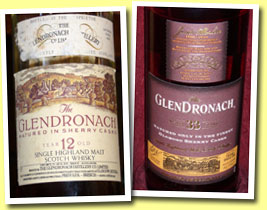 |
Glendronach
12 yo (43%, OB for Previ Brescia,
sherry casks, early-mid 1980’s)
 Colour: coffee. Nose: very dry at
first nosing but soon to get both
very herbal (aromatic herbs) and
animal. Quite some thyme and rosemary,
lovage, balsamico and soy sauce
(or even Japanese oyster sauce).
Goes on with huge notes of oxtail,
game, lots of fresh parsley…
Truly amazing, I love it! No sweetness
whatsoever, except for maybe Smyrna
raisins and old armagnac. Beautiful.
Colour: coffee. Nose: very dry at
first nosing but soon to get both
very herbal (aromatic herbs) and
animal. Quite some thyme and rosemary,
lovage, balsamico and soy sauce
(or even Japanese oyster sauce).
Goes on with huge notes of oxtail,
game, lots of fresh parsley…
Truly amazing, I love it! No sweetness
whatsoever, except for maybe Smyrna
raisins and old armagnac. Beautiful.
|
| Mouth:
oh yes, we’re in the same
territories. Starts on unsugared
coffee but also oxtail (not mixed,
eh), soy sauce, salted liquorice,
balsamic vinegar again, a little
bitter caramel, bread crust…
We do have a certain sweetness now
(roasted nuts, pecans, fruitcake)
but it’s still beautifully
dry and meaty globally. Keeps going
on with reduced beef sauce, gravy,
notes of Madeira… A huge personality.
Finish: maybe a tad short but superbly
liquoricy, salty and coffeeish,
with alos notes of kirsch and plum
eau-de-vie. State of the art! 92
points (would have been
even higher with a longer finish
– and thanks, Luc!) |
Glendronach
33 yo (40%, OB, oloroso, 2006?)
 Interesting to taste this new one
that was probably distilled in the
same years as the old 12yo. Too
bad they didn’t bottle it
at at least 43%. Colour: coffee
– just the same. Nose: surprisingly
similar at first nosing (soy sauce
and herbs) but getting much fruitier
and spicier after a while. Lots
of orange marmalade, cooked strawberries,
a little pepper, cigar box, sandalwood,
whiffs of incense… Slightly
smoky and gingery. We have also
a little clove, Chinese anise, also
smoked ham. Really complex and rich
but still very elegant. Rounder
than the old 12 yo but just as great.
Mouth: very nice attack on bold
notes of pineapple (soaked in rum)
and very ripe melons but the whole
is slightly weak (slightly disappointing
mouth feel, lacking body). Now,
the profile is great, with lots
of sultanas, bitter chocolate, cocoa
(slightly drying), violet and aniseed
sweets, orange blossom, black toffee.
Hints on mint drops. Gets just a
tad drying after a (long) moment.
Finish: medium long, really on sherry,
roasted nuts and cocoa again, getting
just a little cardboardy (tannins).
A beautiful whisky, maybe just a
tad too weakish and drying on the
palate to make it over 89
points.
Interesting to taste this new one
that was probably distilled in the
same years as the old 12yo. Too
bad they didn’t bottle it
at at least 43%. Colour: coffee
– just the same. Nose: surprisingly
similar at first nosing (soy sauce
and herbs) but getting much fruitier
and spicier after a while. Lots
of orange marmalade, cooked strawberries,
a little pepper, cigar box, sandalwood,
whiffs of incense… Slightly
smoky and gingery. We have also
a little clove, Chinese anise, also
smoked ham. Really complex and rich
but still very elegant. Rounder
than the old 12 yo but just as great.
Mouth: very nice attack on bold
notes of pineapple (soaked in rum)
and very ripe melons but the whole
is slightly weak (slightly disappointing
mouth feel, lacking body). Now,
the profile is great, with lots
of sultanas, bitter chocolate, cocoa
(slightly drying), violet and aniseed
sweets, orange blossom, black toffee.
Hints on mint drops. Gets just a
tad drying after a (long) moment.
Finish: medium long, really on sherry,
roasted nuts and cocoa again, getting
just a little cardboardy (tannins).
A beautiful whisky, maybe just a
tad too weakish and drying on the
palate to make it over 89
points. |
|
|
|
October
15, 2006 |
|
 |
| PETE
McPEAT AND JACK WASHBACK |
| TASTING
– HIGHLAND PARK: TWO BEAUTIES
AND QUITE A BEAST |
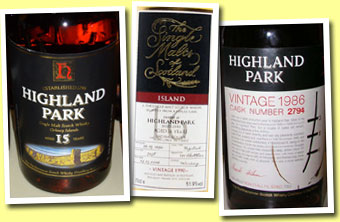 |
Highland
Park 15 yo (40%, OB, 2006)
 Colour: gold. Nose: lots happening!
Huge notes of heather – not
just a myth -, nectar and honey
mingling with very ripe oranges
and whiffs of wood smoke.
Colour: gold. Nose: lots happening!
Huge notes of heather – not
just a myth -, nectar and honey
mingling with very ripe oranges
and whiffs of wood smoke. |
| A
great surprise. A very elegant oakiness
bringing a little vanilla, white
pepper, cinnamon and quite some
ginger to the feast. It keeps then
developing on smoked meat (Islay
beef?), a little coal, caramel,
kumquats, and something frankly
maritime (sea breeze) plus enjoyable
ripe apple notes. Excellent despite
the low strength. Mouth: not weak
or watery at all, juts the mouth
feel is slightly thin… Lots
of honey and chocolate together
with crystallized oranges and a
little nutmeg. Simpler than the
nose, for sure, but still very enjoyable.
Gets rather smoky and slightly peppery
after a moment, with also even more
crystallized fruits. That’s
all but that’s enough! Finish:
medium long and maybe thin now but
certainly not weak, still on chocolate,
oranges and quite some smoke. Again,
a very good surprise, especially
on the nose. 88 points. |
Highland
Park 16 yo 1990/2006 (51.9%, The
Single Malts of Scotland, hogshead,
291 bottles)  Colour white wine. Nose: very different!
Really powerful, starting on rather
weird notes of wet cardboard, plastic,
soap and lots of paraffin. Quite
bizarre… Let’s give
this one a little time, maybe it’s
something very volatile… zzz…
zzz… Right, let’s see:
that worked, these odd aromas almost
vanished, leaving room for quite
some flowers (violets, lavender)
and butter. It’s still a little
cardboardy but much more enjoyable,
with also a little coconut, vanilla,
quite some ginger tonic, bay leaves
and juniper… Very unusual,
hence interesting. Mouth: very bizarre
again, with quite some cheese crust,
cardboard, rotting oranges, aspirin…
And again it’s getting much
better after a while. It’s
not a whisky, it’s a happening!
Now we have quite some bitter oranges,
beer (Guinness but also bitters),
all sorts of herbs (and that famous
Jägermeister) and many spices
(mostly cumin, green curry…)
Immensely unusual, to the point
where I don’t quite know what
to think about it… Especially
the finish is long but very herbal
and strangely bitter. Well, it’s
probably me… Please tell me
what you think if you already tried
this one. For the moment, I’m
rather lost and I’ll just
put temporary stars (thanks for
your understanding ;-)).
Colour white wine. Nose: very different!
Really powerful, starting on rather
weird notes of wet cardboard, plastic,
soap and lots of paraffin. Quite
bizarre… Let’s give
this one a little time, maybe it’s
something very volatile… zzz…
zzz… Right, let’s see:
that worked, these odd aromas almost
vanished, leaving room for quite
some flowers (violets, lavender)
and butter. It’s still a little
cardboardy but much more enjoyable,
with also a little coconut, vanilla,
quite some ginger tonic, bay leaves
and juniper… Very unusual,
hence interesting. Mouth: very bizarre
again, with quite some cheese crust,
cardboard, rotting oranges, aspirin…
And again it’s getting much
better after a while. It’s
not a whisky, it’s a happening!
Now we have quite some bitter oranges,
beer (Guinness but also bitters),
all sorts of herbs (and that famous
Jägermeister) and many spices
(mostly cumin, green curry…)
Immensely unusual, to the point
where I don’t quite know what
to think about it… Especially
the finish is long but very herbal
and strangely bitter. Well, it’s
probably me… Please tell me
what you think if you already tried
this one. For the moment, I’m
rather lost and I’ll just
put temporary stars (thanks for
your understanding ;-)). |
Highland
Park 1986 'vintage' (56.2%, OB,
UK, cask #2794, 648 bottles, circa
2006)  Colour: mahogany. Nose: a superb
sherry now, with as much toffee
and fruit jam as one can get plus
a fantastic meatiness and lots of
smoke. Incredibly elegant, bold
yet so subtle… So, in no particular
order, we have: high-end perfume
in the Joy de Patou genre (nothing
offending at all), dried oranges,
strawberry jam, buttered caramel,
oak smoke, smoked ham, old white
Burgundy of the best kind, idem
red, roasted nuts, old books, hot
black truffles, cinchona, orange
liqueur, smoked tea, chocolate,
espresso coffee… Well, better
stop now, I haven’t gotten
all day. Mouth: … imagine
the palate just matches the fantastic
nose! Maybe just hints of sulphur
at the attack but they don’t
last for long and then it’s
the charge of the light brigade
(again!) on all flavours you can
get in a great sherry (from oranges
to smokiness and from chocolate
to balsamic vinegar). Too bad it
gets just a tad bitterish and sourish
towards the finish, thanks to the
very high sherry concentration.
The finish itself is extremely long
and concentrated as expected, fruity,
jammy and now rather herbal (rosemary),
getting even very minty- lots of
cloves as well… A true sherry
monster for true sherryheads, that’s
for sure. Too bad it was sometimes
slightly sulphury/rubbery, otherwise
it would have fetched much more
that 91 points.
Colour: mahogany. Nose: a superb
sherry now, with as much toffee
and fruit jam as one can get plus
a fantastic meatiness and lots of
smoke. Incredibly elegant, bold
yet so subtle… So, in no particular
order, we have: high-end perfume
in the Joy de Patou genre (nothing
offending at all), dried oranges,
strawberry jam, buttered caramel,
oak smoke, smoked ham, old white
Burgundy of the best kind, idem
red, roasted nuts, old books, hot
black truffles, cinchona, orange
liqueur, smoked tea, chocolate,
espresso coffee… Well, better
stop now, I haven’t gotten
all day. Mouth: … imagine
the palate just matches the fantastic
nose! Maybe just hints of sulphur
at the attack but they don’t
last for long and then it’s
the charge of the light brigade
(again!) on all flavours you can
get in a great sherry (from oranges
to smokiness and from chocolate
to balsamic vinegar). Too bad it
gets just a tad bitterish and sourish
towards the finish, thanks to the
very high sherry concentration.
The finish itself is extremely long
and concentrated as expected, fruity,
jammy and now rather herbal (rosemary),
getting even very minty- lots of
cloves as well… A true sherry
monster for true sherryheads, that’s
for sure. Too bad it was sometimes
slightly sulphury/rubbery, otherwise
it would have fetched much more
that 91 points. |
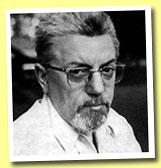 |
MUSIC
- Recommended
listening - It's Sunday, we go
classical with Bernd
Alois Zimmermann's
Musique
pour les soupers du Roi Ubu.mp3
(composed in 1968 - played by
Rundfunks-Sinfonie-Orchester Köln,
conducted by Michael Gielen in
1972). Extremely entertaining,
with funny quotes of Lully (of
course) but also Mussorgski, Ellington
and many others. Great collage! |
Check
the index of all entries:
Whisky
Music
Nick's Concert
Reviews |
 |
 |
 |
|
| |
Best
malts I had these weeks - 90+
points only - alphabetical:
Bowmore
30 yo 1972/2002 (50.3%,
Signatory, cask #928, 192 bottles)
Bowmore
1968/2006 (41.5%, The Taste Still,
cask #3823, 144 bottles, Belgium)
Bunnahabhain
33 yo 1967/2001 (41.25%,
Douglas Laing Old Malt, US, 204 bottles)
Glendronach
12 yo (43%, OB for Previ Brescia, sherry
casks, early-mid 1980’s)
Highland
Park 1986 'vintage' (56.2%, OB, UK,
cask #2794, 648 bottles, circa 2006)
Highland
Park 35 yo 1962/1997 (Cask Strength,
OB, John Goodwin retirement)
Port
Ellen 27 yo 1978/2006 (54.2%, OB, 6th
Release, 4560 bottles)


|
| |
|
|



